Pigeons are a common species of bird that can be found all over the world. These birds are known for their distinctive cooing sound and their ability to be trained to carry messages.
Pigeons have been used throughout history as messengers, and they are also the subject of several cultural and scientific studies.
They have a unique set of behaviors and characteristics that make them fascinating to study and observe.
1. Rock Dove
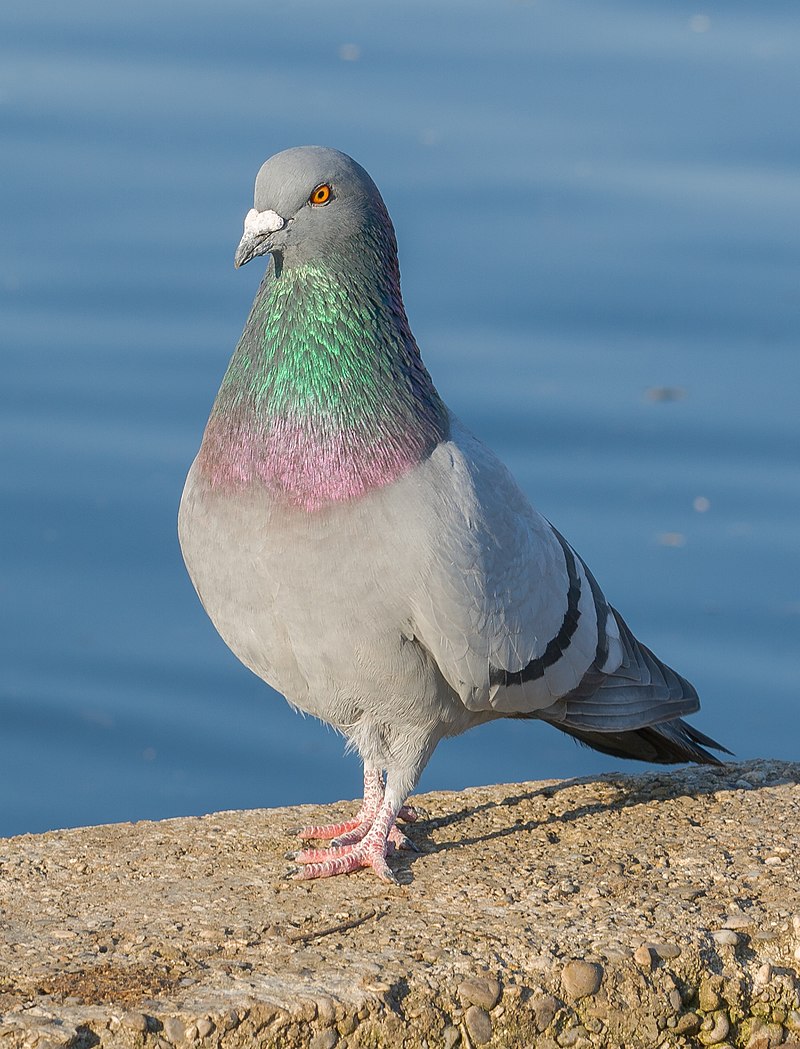
Rock dove, also known as Rock Pigeon or Common Pigeon, is a member of the bird family Columbidae.
It is considered to be an important creature worldwide due to its domestication by humans centuries ago; resulting in the modern-day Domestic pigeon which descends from this species.
Its population has increased over time because some domestic pigeons have escaped captivity and joined wild populations.
The rock dove can most easily be identified by its prominent blue-grey feathers with darker bars on wings and tail along with two black bands on each wing.
They are typically found in large flocks near cliffs or buildings but may also inhabit rural habitats such as open fields and meadows if there’s enough food available for them nearby.
Although they don’t migrate far distances like other birds, their numbers increase significantly during winter months.
When more food sources become available closeby so that they won’t need to travel too far away from home base for nourishment.Scientific classification:
| Kingdom | Animalia |
| Phylum | Chordata |
| Class | Aves |
| Order | Columbiformes |
| Family | Columbidae |
| Genus | Columba |
| Species | C. livia |
2. Mourning Dove
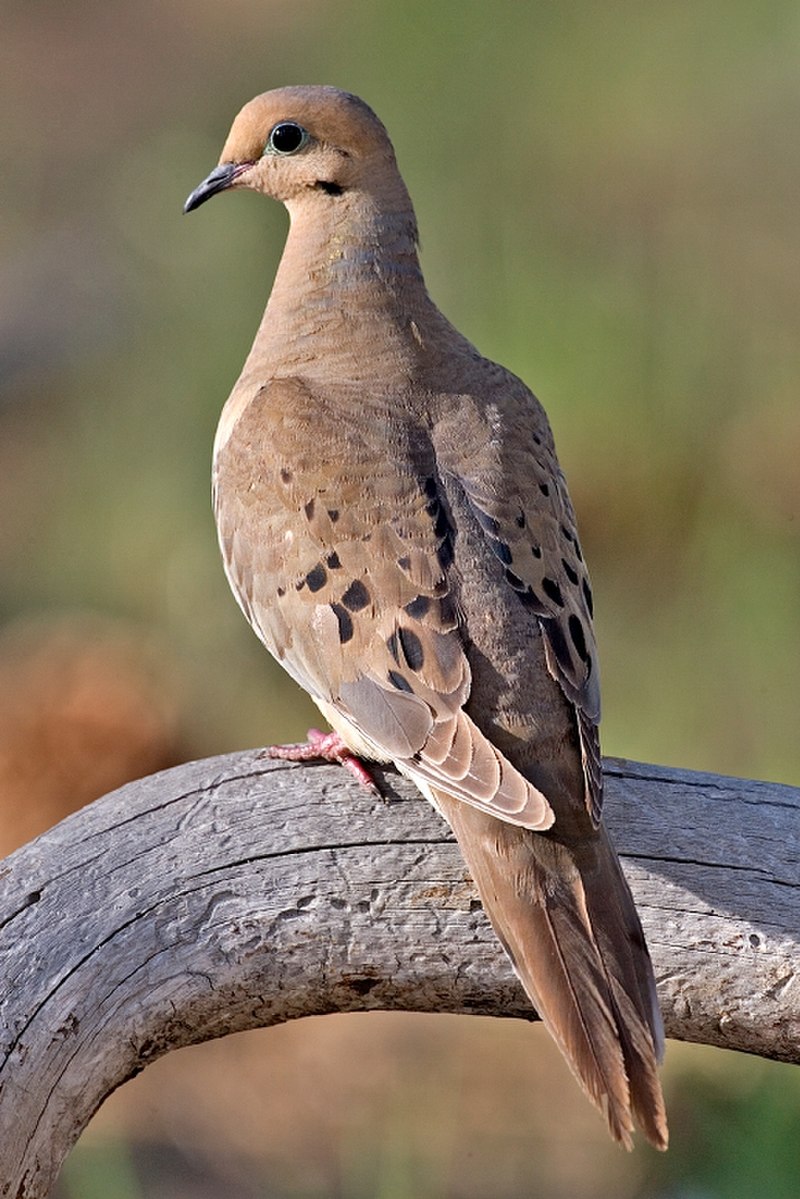
The Mourning Dove is a breathtakingly beautiful bird. It has stunning gray and brown feathers with white tipped wings, giving it an elegant appearance. Its long tail also adds to its graceful look in flight.
A symbol of peace and serenity, they are abundant across North America and can be found in gardens or open fields throughout the year.
As well as being popular game birds for hunters, they feed on grains such as wheat and millet providing important food sources for wildlife species including foxes, coyotes, skunks and raccoons.
These doves have a distinctive cooing sound that can often be heard echoing through woodlands during summer evenings making them one of nature’s greatest treasures.Scientific classification:
| Kingdom | Animalia |
| Phylum | Chordata |
| Class | Aves |
| Order | Columbiformes |
| Family | Columbidae |
| Genus | Zenaida |
| Species | Z. macroura |
3. Eurasian Collared Dove
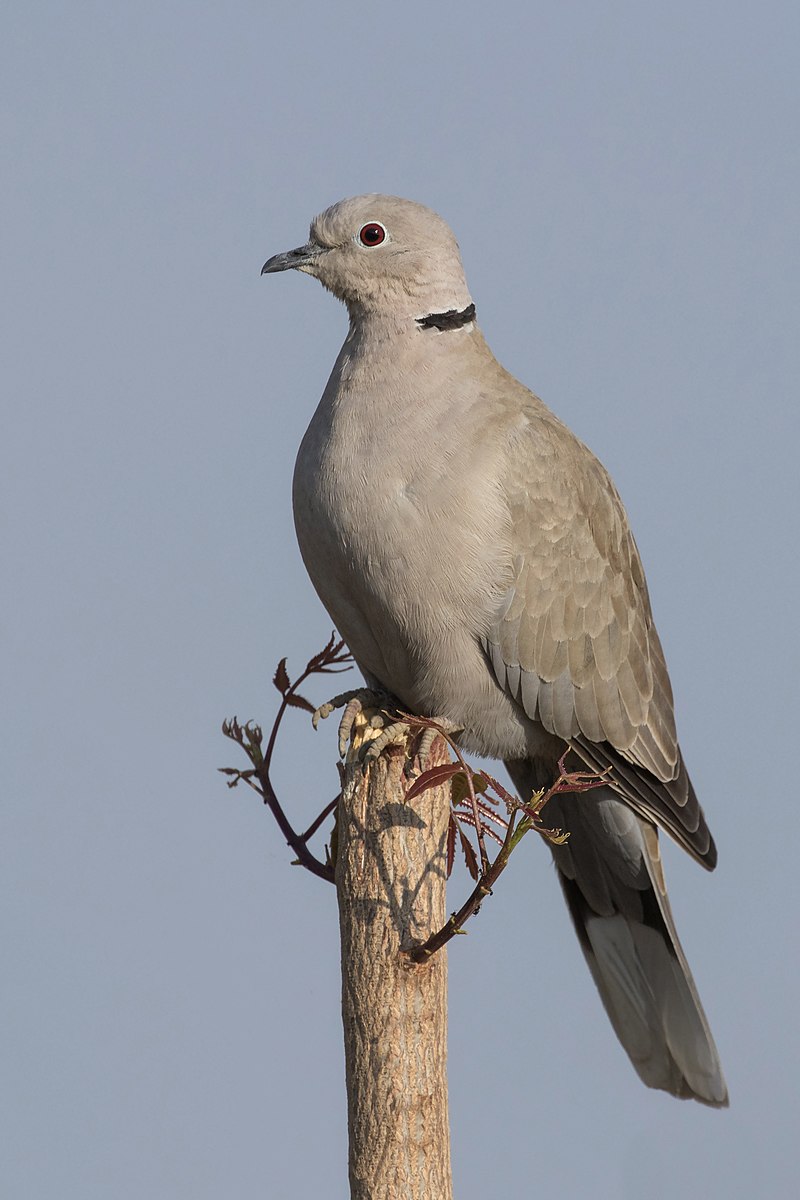
The Eurasian collared dove is a species of bird native to Europe and Asia, with its range expanding through introduction in Japan, North America, and islands in the Caribbean.
It has become so widespread that it is listed as Least Concern on the IUCN Red List. The scientific name for this bird was proposed by Hungarian naturalist Imre Frivaldsz – Columba decaocto.
This beautiful creature typically measures between 33-37 cm from tip to tail feathers, displaying an overall greyish brown plumage; they also have distinctive black half collar around their neck which gives them their common name.
These birds are mainly found inhabiting open woodlands or agricultural lands near human settlements where there’s plenty of food available such as grain fields or gardens where fruits can be eaten off trees.
With a vast global population trend increasing steadily each year these birds make great additions to many backyards throughout the world.Scientific classification:
| Kingdom | Animalia |
| Phylum | Chordata |
| Class | Aves |
| Order | Columbiformes |
| Family | Columbidae |
| Genus | Streptopelia |
| Species | S. decaocto |
4. Common Wood Pigeon
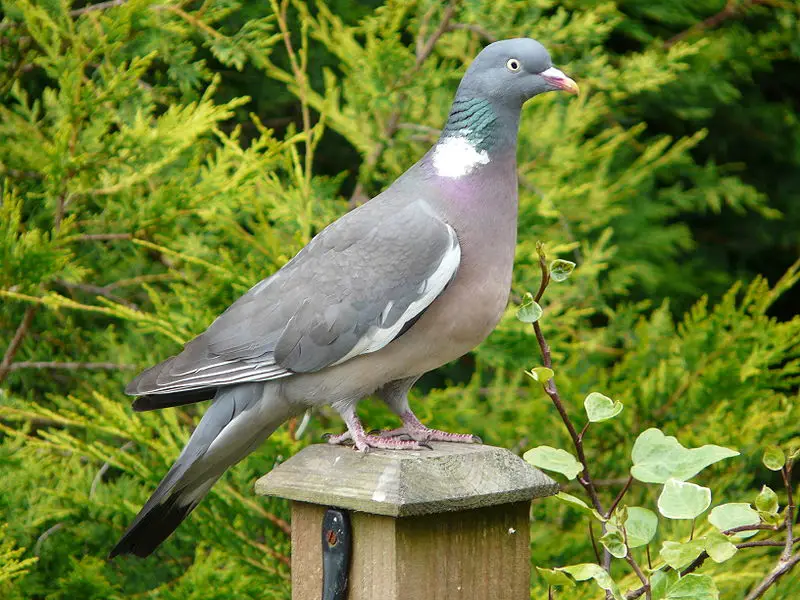
The Common Wood Pigeon is a large bird of the dove and pigeon family, native to the western Palearctic. It has grey plumage with white patches on its wings and neck.
Its head often appears darker than its body due to iridescence in some parts of its feathers. The male woodpigeons have pinkish breasts while females are more brownish-grey coloured.
These birds feed mainly on seeds, fruits, flowers and leaves but will also eat insects when available.
They breed during springtime producing 1-2 clutches per breeding season with two eggs each time which hatch after about 18 days incubation period by both parents taking turns for duty.
They make their nests from twigs collected from nearby trees or places close by and usually raise only one brood at a time making them an important part of nature’s balance as they help keep insect populations under control through their diet choices.Scientific classification:
| Kingdom | Animalia |
| Phylum | Chordata |
| Class | Aves |
| Order | Columbiformes |
| Family | Columbidae |
| Genus | Columba |
| Species | C. palumbus |
5. European Turtle Dove
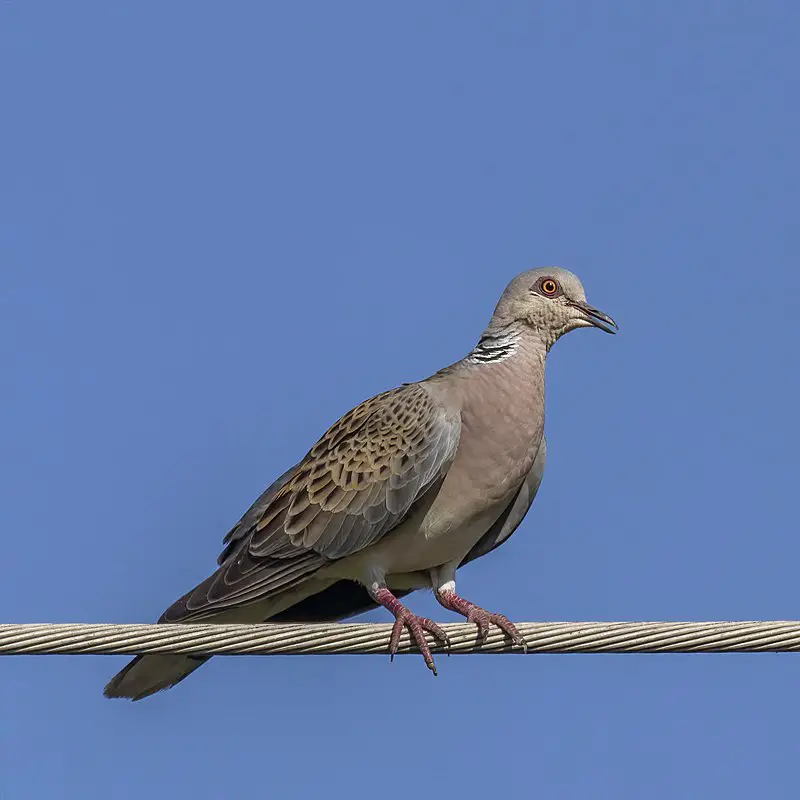
The European turtle dove is a beautiful bird belonging to the Columbidae family of doves and pigeons. It has a wide range across south western Palearctic, including northern Africa, but migrates to sub-Saharan Africa in winter.
The species was officially described by Carl Linnaeus in 1758 as part of his Systema Naturae. This small yet elegant creature can be recognized by its distinctive reddish-brown color with black spots on its wings and tail feathers.
Its underparts are yellowish white while it’s back is grey with dark streaks that run through it making for an attractive patterned plumage.
They feed mainly on grains found on grasslands or near roadsides and have a unique cooing call which makes them easily distinguishable amidst other birdsong.Scientific classification:
| Kingdom | Animalia |
| Phylum | Chordata |
| Class | Aves |
| Order | Columbiformes |
| Family | Columbidae |
| Genus | Streptopelia |
| Species | S. turtur |
6. Common Ground Dove
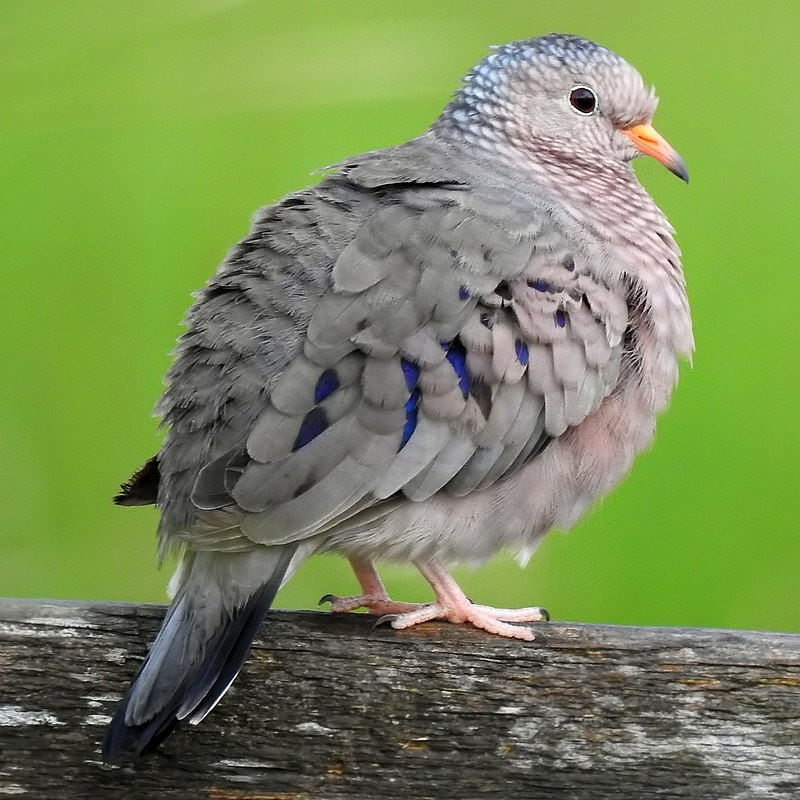
The Common Ground Dove is a small bird that can be found in the southern United States, Central America, the Caribbean and northern South America.
It’s considered to be one of the smallest dove species in North American with an average length of around 6–7 inches.
This ground-dwelling species spends most of its time on foot but has been known to fly when necessary or threatened.
The plumage is pale grayish brown above while their bellies are white and speckled with black spots along their wings.
Its diet consists mainly of seeds from grasses and other low vegetation which it forages for by walking slowly across open fields or lawns looking for food items like berries, grains, insects, spiders and snails.Scientific classification:
| Kingdom | Animalia |
| Phylum | Chordata |
| Class | Aves |
| Order | Columbiformes |
| Family | Columbidae |
| Genus | Columbina |
| Species | C. passerina |
7. White-Crowned Pigeon
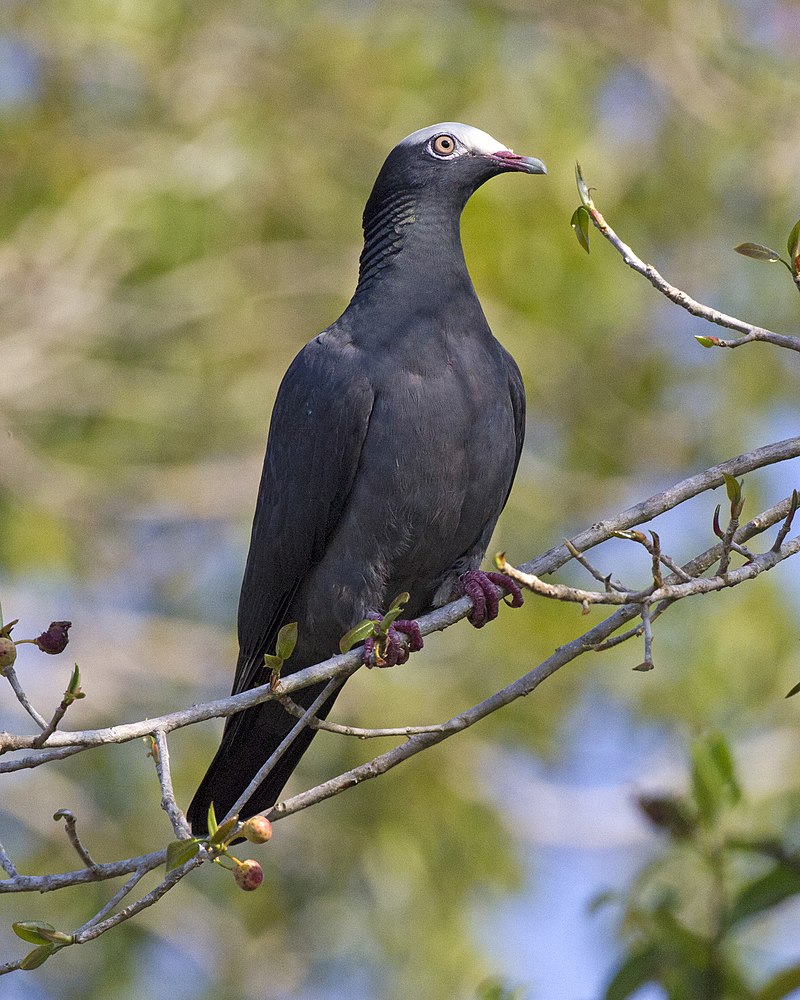
The White-crowned Pigeon is a species of bird belonging to the Columbidae family, widely found in the Caribbean. In the first half of the 18th century it was described as such.
This pigeon has been immortalized by artist John James Audubon through his watercolor painting featured in Birds of America published during early 19th century.
These birds primarily feed on fruits and seeds and have white crowns that make them easily recognizable even from afar.
The beauty of these birds makes them popular amongst birdwatchers all over the world who flock to observe their behavior while they eat or nest.Scientific classification:
| Kingdom | Animalia |
| Phylum | Chordata |
| Class | Aves |
| Order | Columbiformes |
| Family | Columbidae |
| Genus | Patagioenas |
| Species | P. leucocephala |
8. Pink-Necked Green Pigeon
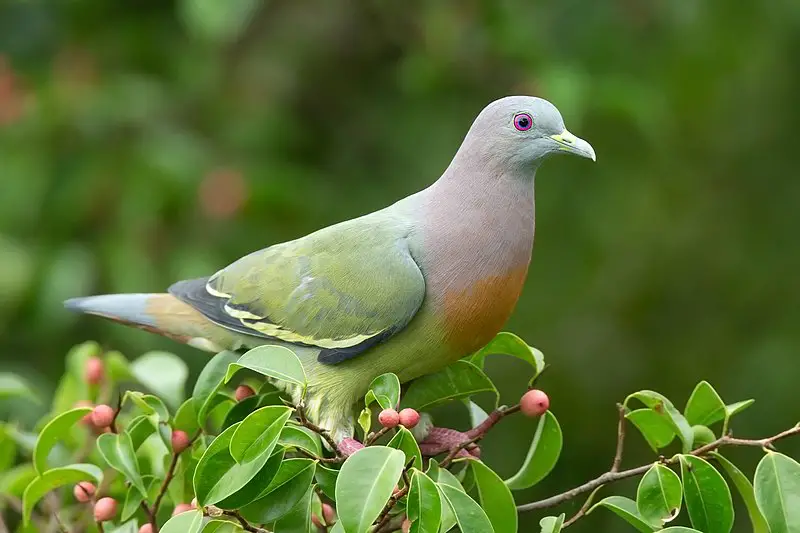
The Pink-necked green pigeon is a beautiful bird of the Columbidae family, native to Southeast Asia. Its body is mainly covered with emerald feathers and only the male has an eye-catching pink neck.
It can be found from Myanmar and Vietnam down to Indonesia and even in parts of Philippines, where it’s known as “punay”.
This medium sized species loves feeding on fruits such as figs or guavas but also enjoys snacking on insects from time to time.
In its natural habitat, this colorful avian often nests high up in trees for better protection against predators.
All in all, the unique beauty of Pink-necked Green Pigeon makes it one truly remarkable bird.Scientific classification:
| Kingdom | Animalia |
| Phylum | Chordata |
| Class | Aves |
| Order | Columbiformes |
| Family | Columbidae |
| Genus | Treron |
| Species | T. vernans |
9. White-Winged Dove
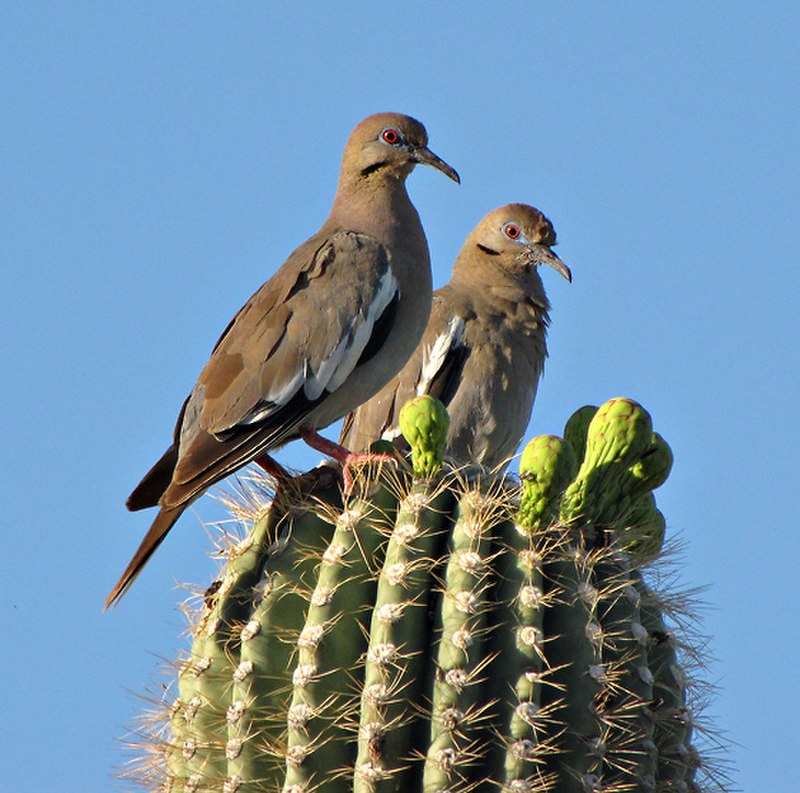
The White-winged Dove is an impressive bird with a large body and wingspan. Its distinctive feature is the white edge on its wings, which makes it easily recognizable when in flight.
It has blue eyerings, red eyes and gray plumage, while juveniles are duller in coloration than adults.
This dove species inhabits areas from Southwestern United States through Mexico to Central America as well as Caribbean islands.
They usually live close to human settlements or cities but can also be found in agricultural fields feeding on grains like corn or wheat seeds left by farmers after harvest season ends.
In their natural habitat they feed primarily on insects, fruits and small plants such as certain cacti species.Scientific classification:
| Kingdom | Animalia |
| Phylum | Chordata |
| Class | Aves |
| Order | Columbiformes |
| Family | Columbidae |
| Genus | Zenaida |
| Species | Z. asiatica |
10. Stock Dove
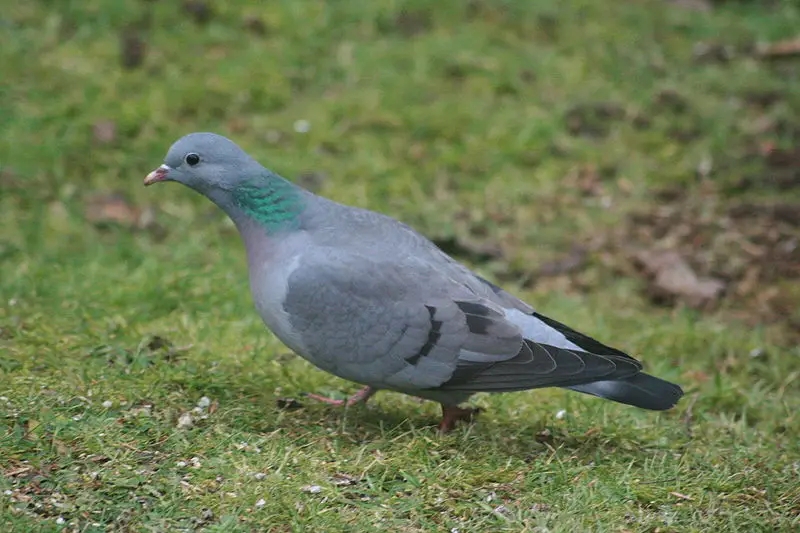
The Stock Dove is a species of bird in the Columbidae family, commonly found across the western Palearctic.
It was first documented by Swedish Naturalist Carl Linnaeus as part of his Systema Naturae publication back in 1758 and given its scientific name – Columba oenas.
Its body has an overall grey-blue colouration with darker wings, while they sport a small white patch on their neck and dark spots along their chest area.
They mainly feed on seeds but can also be seen eating insects or other invertebrates during summertime.
These birds are often heard before being spotted due to their loud cooing sound which echoes through woodlands near lakes and rivers where they typically nest; either low down in trees or sometimes even inside caves.Scientific classification:
| Kingdom | Animalia |
| Phylum | Chordata |
| Class | Aves |
| Order | Columbiformes |
| Family | Columbidae |
| Genus | Columba |
| Species | C. oenas |
11. Passenger Pigeon
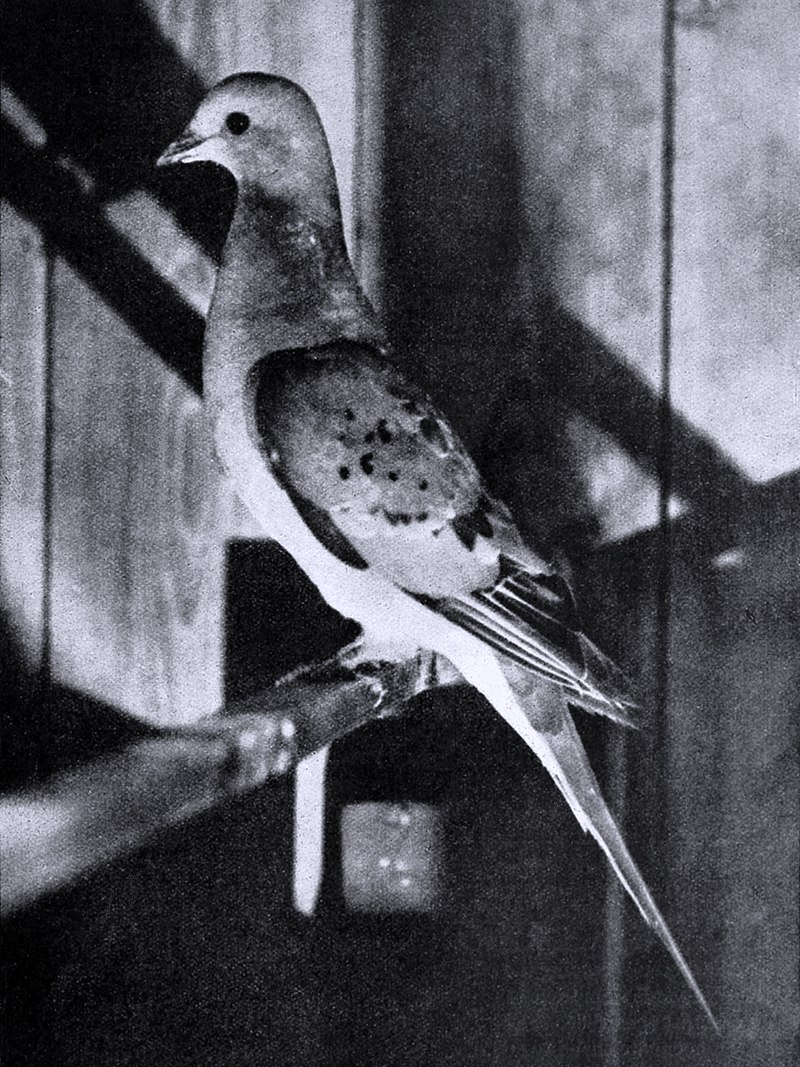
The Passenger Pigeon was a species of pigeon native to North America, characterized by its migratory habits and given the scientific name Ectopistes Migratorius.
Aptly nicknamed ‘Passengers’ due to their frequent movement around the continent in large flocks, they were an incredibly abundant species until their abrupt extinction at the start of the 20th century.
Once thought to be closely related with today’s Mourning Dove due to similar morphological features, we now know that although both birds are part of Columbidae family; they belong in different genera entirely.
The Passenger Pigeon is believed to have been driven into oblivion mainly because of deforestation and hunting pressures which caused them go extinct within just a few decades – something that serves as reminder for us all on how fragile wildlife can truly be if not respected properly.Scientific classification:
| Kingdom | Animalia |
| Phylum | Chordata |
| Class | Aves |
| Order | Columbiformes |
| Family | Columbidae |
| Genus | †Ectopistes Swainson, 1827 |
| Species | †E. migratorius |
12. Crested Pigeon
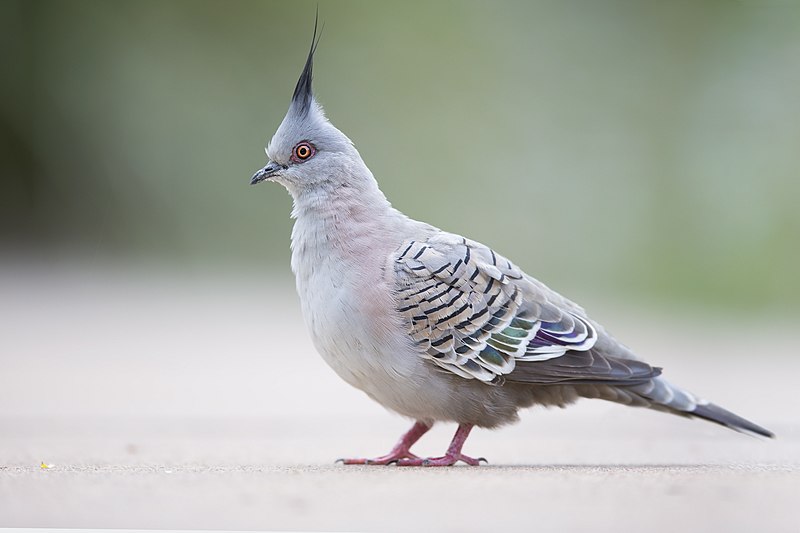
The Crested Pigeon is a medium-sized bird found widely across mainland Australia. It stands out from other pigeons due to its unique erect crest on the top of its head, which gives it an unmistakable look.
The body of this pigeon is slate grey in color with lighter gray undersides and chestnut colored wings that have white tips when they are open while flying.
Its striking black tipped yellow beak and pale blue eye ring add further interest to this beautiful species.
When alarmed, these birds will make loud clapping sounds by bringing their wings together above their backs as part of their defensive behavior.Scientific classification:
| Kingdom | Animalia |
| Phylum | Chordata |
| Class | Aves |
| Order | Columbiformes |
| Family | Columbidae |
| Genus | Ocyphaps G.R. Gray, 1842 |
| Species | O. lophotes |
13. Western Crowned Pigeon
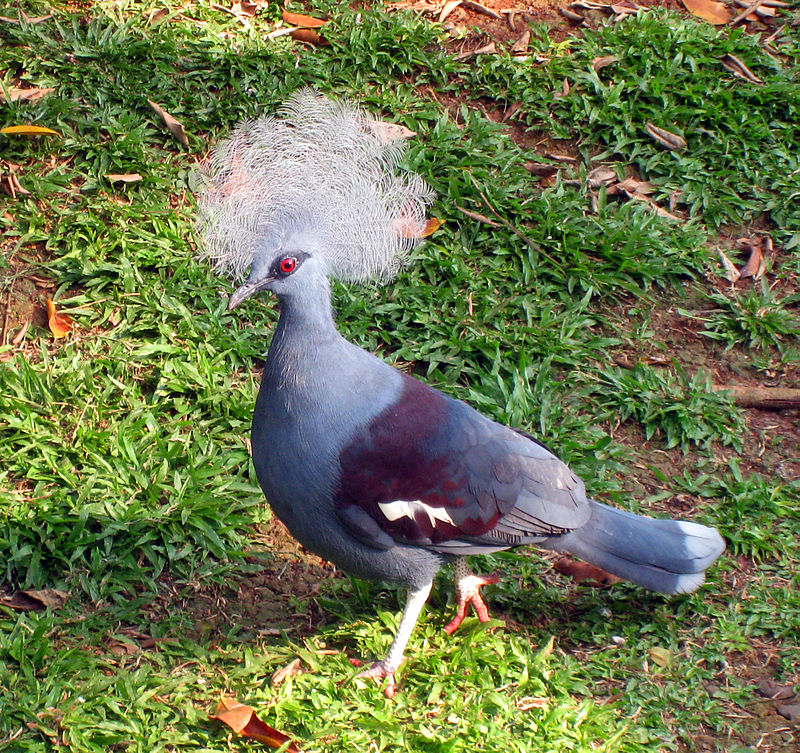
The Western crowned pigeon is a majestic bird with an impressive size and striking features. Its bright blue-grey feathers are decorated with lacy crests over the head and dark blue masking around its eyes, making it quite distinct from other species of pigeons.
Males tend to be larger than females, growing up to 70 cm in length and weighing approximately 2 kgs.
These birds originate from New Guinea but can also be found in some parts of Australia.
They feed mostly on fruits as well as seeds and small invertebrates like beetles or snails which they forage while walking along the ground or flying low through the forest canopy.
They form strong pairs during breeding season, building nests at higher levels out of branches that they weave together using twigs.Scientific classification:
| Kingdom | Animalia |
| Phylum | Chordata |
| Class | Aves |
| Order | Columbiformes |
| Family | Columbidae |
| Genus | Goura |
| Species | G. cristata |
14. Ruddy Ground Dove
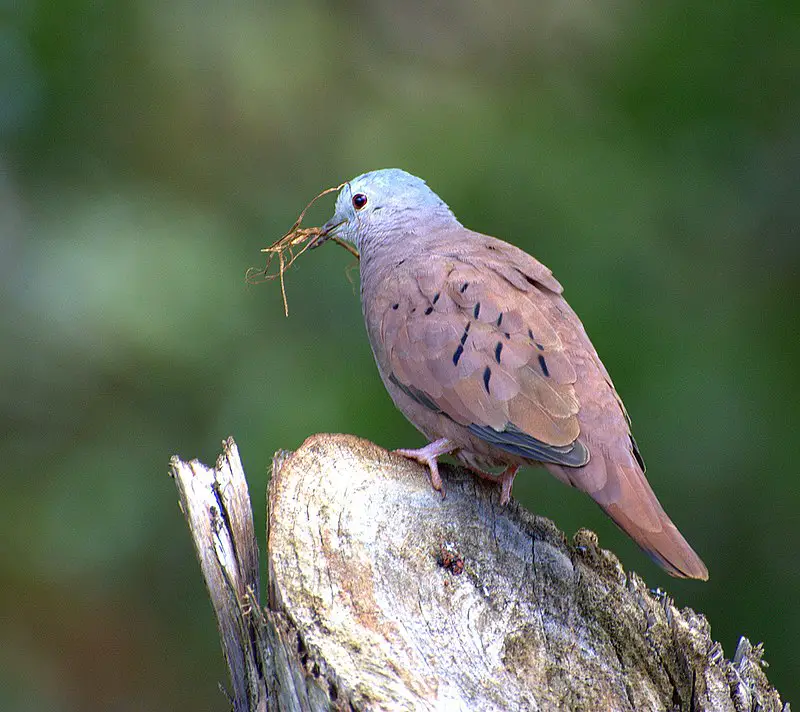
The Ruddy Ground Dove is a small New World tropical bird, found across Mexico and South America as far south as Argentina. It is also seen in the southwestern United States during winter months.
This ground dove typically lives in scrub or other open habitats such as savannas and grasslands, where it feeds on seeds from plants like cactus fruits.
Its plumage ranges from grey to reddish-brown with a light tan breast and black markings throughout its wings and tail feathers.
The male has more distinguishable colouration than the female but both sexes have bright red eyes which give this species its name – ‘ruddy’.
They are often observed perching low to the ground near food sources or nesting sites while also being quite vocal when flying between locations making them easier to spot.Scientific classification:
| Kingdom | Animalia |
| Phylum | Chordata |
| Class | Aves |
| Order | Columbiformes |
| Family | Columbidae |
| Genus | Columbina |
| Species | C. talpacoti |
15. Spotted Dove
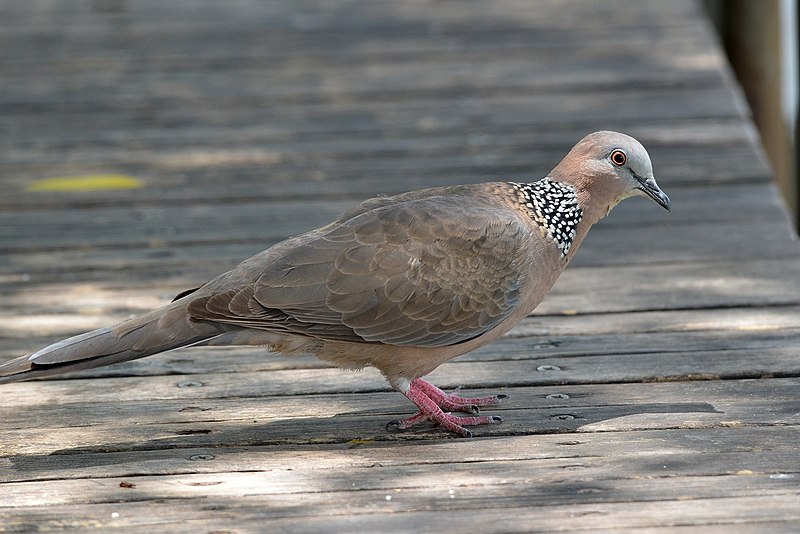
The Spotted Dove is a common species of pigeon found in the Indian subcontinent and Southeast Asia. It has an elegant, slender body with small head, long tail feathers and spotted wings.
Its coloring ranges from grey to brownish-grey on its upperparts with white underparts that are speckled black or dark grey. The male generally has more prominent spots than the female.
They feed mainly on seeds but will also consume insects when available during breeding season as well as berries, grains and fruits throughout their range.
These birds typically live in pairs or small groups near water sources such as ponds, rivers or streams where they can find food easily while staying safe from predators like cats and hawks.Scientific classification:
| Kingdom | Animalia |
| Phylum | Chordata |
| Class | Aves |
| Order | Columbiformes |
| Family | Columbidae |
| Genus | Spilopelia |
| Species | S. chinensis |
16. Victoria Crowned Pigeon
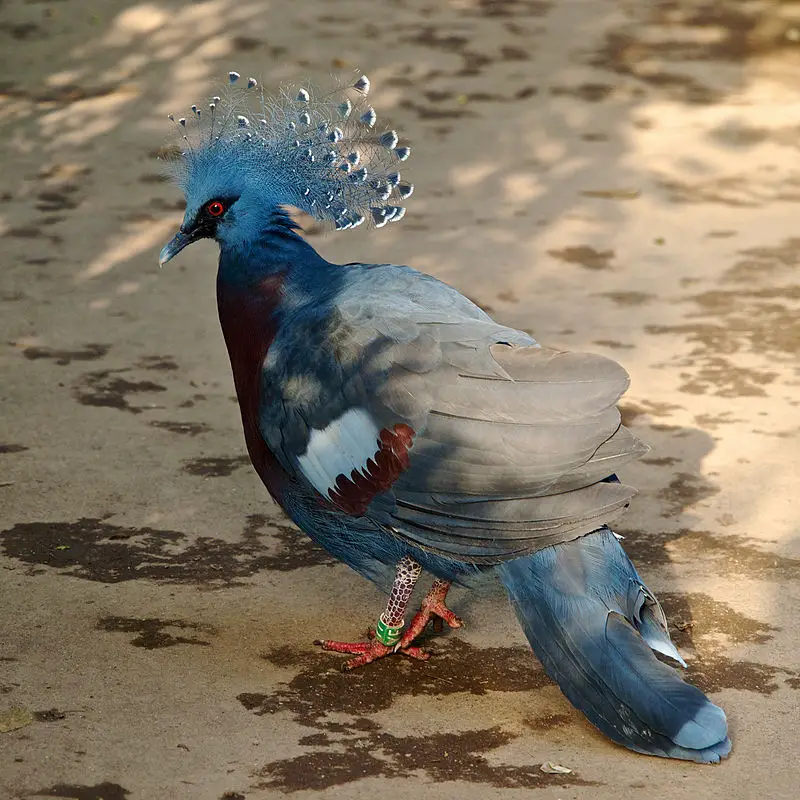
The Victoria crowned pigeon is a stunning bird native to the New Guinea region. With its elegant blue lace-like crests, maroon breast and red irises, it’s unmistakable in appearance.
Its distinct white tips on its crest make it easy to recognize among other species of pigeons. When calling out for mates or prey, this majestic creature makes deep whooping sounds that are sure to catch your attention from afar.
This beautiful bird spends much of its time on the ground rather than in flight like most pigeons do – making them quite unique indeed.
The Victoria crowned pigeon gets its name from Queen Victoria of Great Britain as an homage to her reign when they were first discovered by westerners.Scientific classification:
| Kingdom | Animalia |
| Phylum | Chordata |
| Class | Aves |
| Order | Columbiformes |
| Family | Columbidae |
| Genus | Goura |
| Species | G. victoria |
17. Grenada Dove
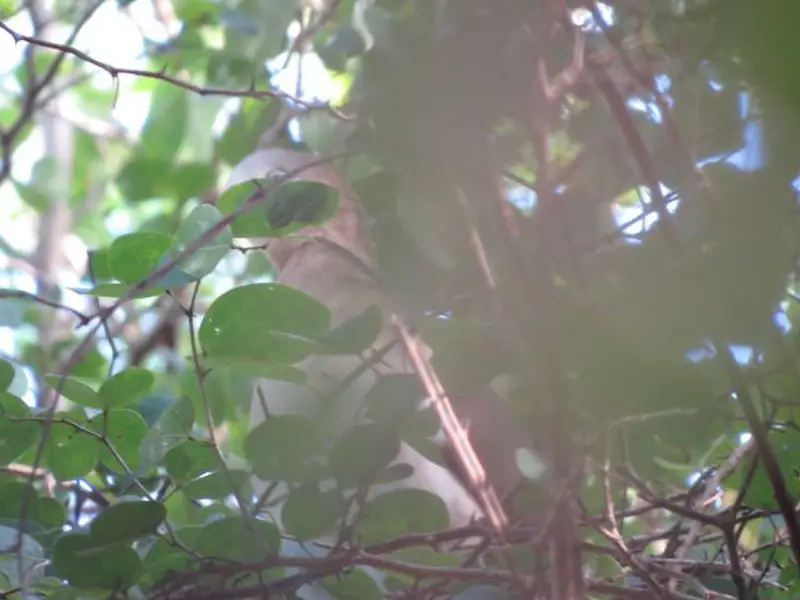
The Grenada Dove is a medium-sized New World tropical dove endemic to the island of Grenada in the Lesser Antilles.
It has been classified as one of the most critically endangered doves in the world by Bird Life International 2000, due to its small population size and limited range.
The bird can be identified by its white throat; greyish-brown back and wings; pink breast with black spots on it; yellow eye ring and legs, along with red eyes.
Its diet mainly consists of fruits, seeds, buds and petals from various plants found on land or near water sources such as ponds or rivers.
This species plays an important role in maintaining natural balance within their habitats by dispersing seeds through defecation which helps regenerate local vegetation patterns over time.
As they are facing extinction threat due to habitat loss caused by human activities like logging & farming practices – conservation efforts must be taken up immediately for protection & preservation of these birds.Scientific classification:
| Kingdom | Animalia |
| Phylum | Chordata |
| Class | Aves |
| Order | Columbiformes |
| Family | Columbidae |
| Genus | Leptotila |
| Species | L. wellsi |
18. Zebra Dove
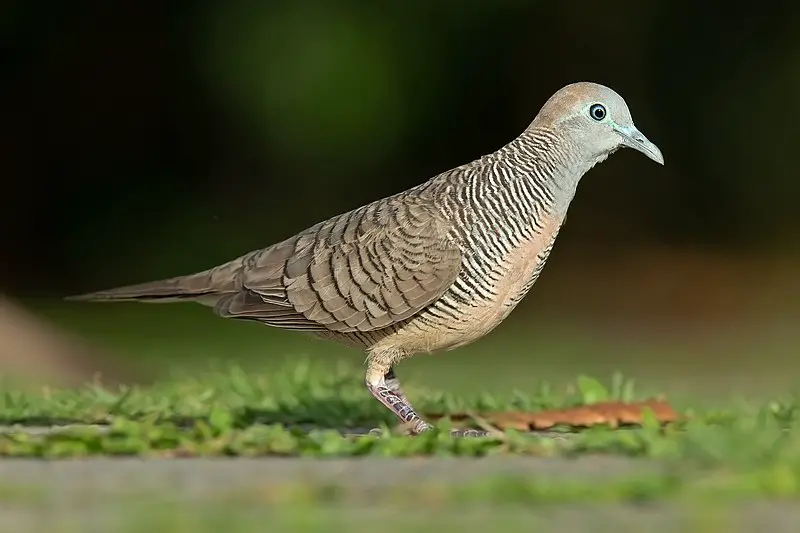
The Zebra Dove is a species of bird belonging to the Columbidae family. It can be found in Southeast Asia, and has predominantly brownish-grey feathers with black-and-white barring.
This dove stands out for its soft, pleasant cooing calls that sound like staccato notes when heard together. George Edwards first described it in 1743 as part of his English naturalist work on birds.
They are small animals with long tails, making them easily identifiable even from afar due to their distinct color patterning.
These doves prefer open woodlands or grassy areas near human settlements where they feed on seeds and insects while nesting close by but still far enough away from disturbance caused by humans or other animals who might disrupt their habitat.
The zebra dove is considered an important symbol among some Asian cultures representing love & beauty , reflecting how this little creature manages to capture people’s hearts wherever it goes.Scientific classification:
| Kingdom | Animalia |
| Phylum | Chordata |
| Class | Aves |
| Order | Columbiformes |
| Family | Columbidae |
| Genus | Geopelia |
| Species | G. striata |
19. Dodo
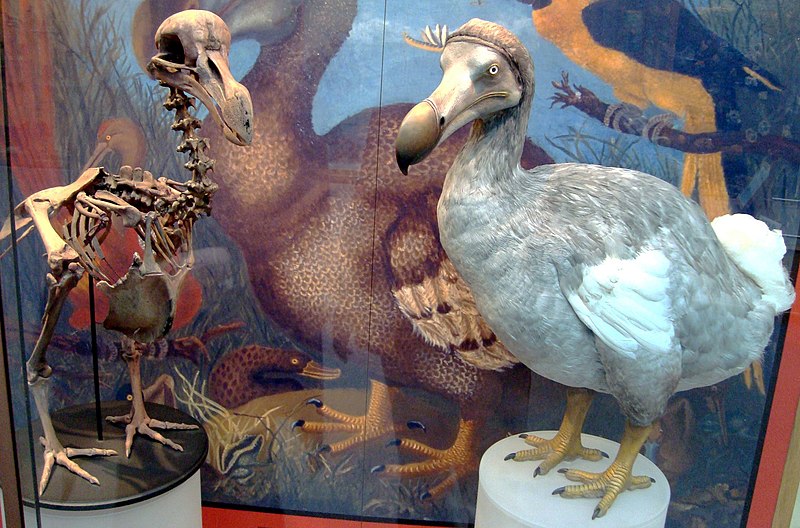
The Dodo bird was a unique species of flightless bird that used to inhabit the island of Mauritius in the Indian Ocean. It had no natural predators and was an easy target for hunters due to its slow movement on land.
The Dodo’s closest living relative is believed to be the common pigeon, although it has since gone extinct.
Its extinction can largely be attributed to hunting by humans as well as cats, pigs and rats that were introduced onto their island home.
While we may never know what this remarkable creature could have been like today, its legacy will always remain with us in our understanding of biodiversity loss caused by human activity.Scientific classification:
| Kingdom | Animalia |
| Phylum | Chordata |
| Class | Aves |
| Order | Columbiformes |
| Family | Columbidae |
| Subfamily | †Raphinae |
| Genus | †Raphus Brisson, 1760 |
| Species | †R. cucullatus |
20. Laughing Dove
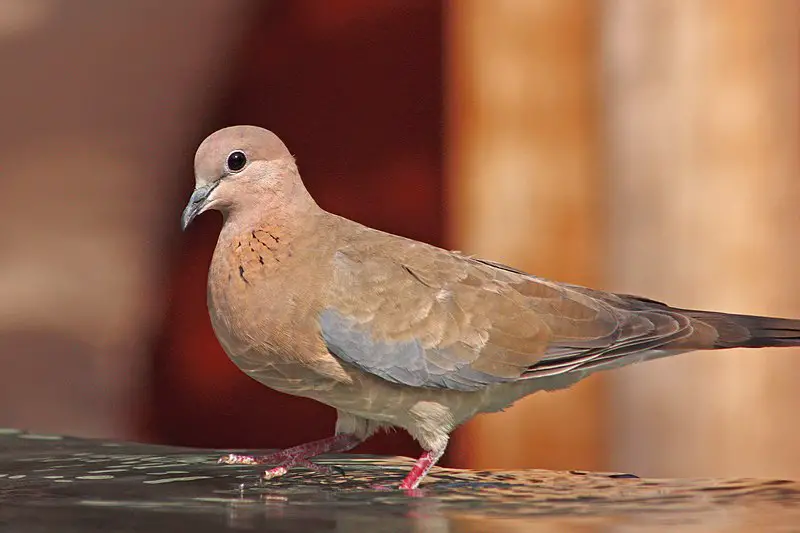
The Laughing Dove is a small and long-tailed pigeon found in dry, scrubby or semi-desert habitats. These birds are native to Africa, the Middle East, South Asia and Western Australia where they were released from Perth Zoo in 1898.
A unique feature of these doves is their call which sounds like low laughter – hence its name.
They form pairs when feeding on the ground, often near water sources such as pools or riverbanks. The diet of this bird consists mainly of seeds with some invertebrates also taking up part of it.
This species has adapted well to different environments due to its ability to find food resources easily even during times when other foods may be scarce.Scientific classification:
| Kingdom | Animalia |
| Phylum | Chordata |
| Class | Aves |
| Order | Columbiformes |
| Family | Columbidae |
| Genus | Spilopelia |
| Species | S. senegalensis |
21. Pied Imperial Pigeon
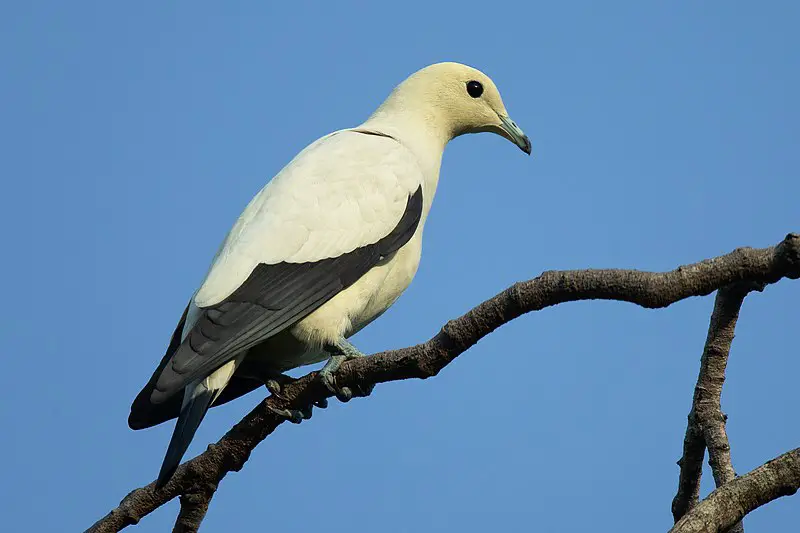
The Pied Imperial Pigeon is a stunning bird native to Southeast Asia. It has striking black and white plumage, with the lower half of its body being predominantly white while its head, neck and upper breast are black.
This species can be found in various habitats such as forests, woodlands, mangroves, plantations and scrub across Myanmar, Thailand Indonesia Philippines & New Guinea regions.
They mainly nest on small islands or coastal areas near coral reefs where they feed primarily on fruits like figs but also occasionally insects & crustaceans too.
These birds form large flocks during breeding season which makes them an impressive sight to behold.Scientific classification:
| Kingdom | Animalia |
| Phylum | Chordata |
| Class | Aves |
| Order | Columbiformes |
| Family | Columbidae |
| Genus | Ducula |
| Species | D. bicolor |
Also Featured In: Birds of Far North Queensland, Beautiful Birds Found in Coron Island
22. Atoll Fruit Dove
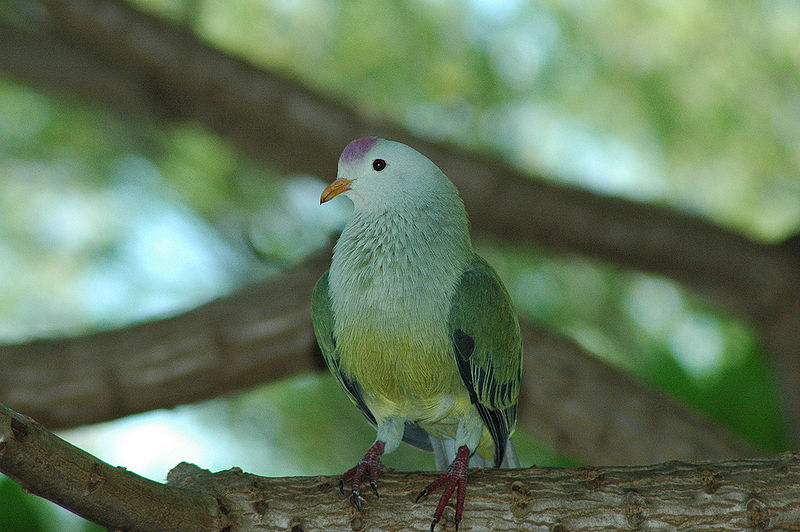
The Atoll Fruit Dove is a species of bird native to the Tuamotu Archipelago in French Polynesia. This small, colorful dove inhabits subtropical and tropical moist lowland forests and plantations.
Unfortunately, it has become threatened due to habitat loss caused by human activity such as logging and development projects.
A 1999 survey found that this species was widespread throughout the islands of the archipelago with an estimated population size ranging from hundreds to thousands individuals.
The Atoll Fruit Dove is easily distinguishable thanks to its bright green upperparts which contrast sharply against its white belly and blue tail feathers.
It also sports yellowish-orange eyespots on both wings making it quite unique among doves worldwide.Scientific classification:
| Kingdom | Animalia |
| Phylum | Chordata |
| Class | Aves |
| Order | Columbiformes |
| Family | Columbidae |
| Genus | Ptilinopus |
| Species | P. coralensis |
23. Tooth-Billed Pigeon
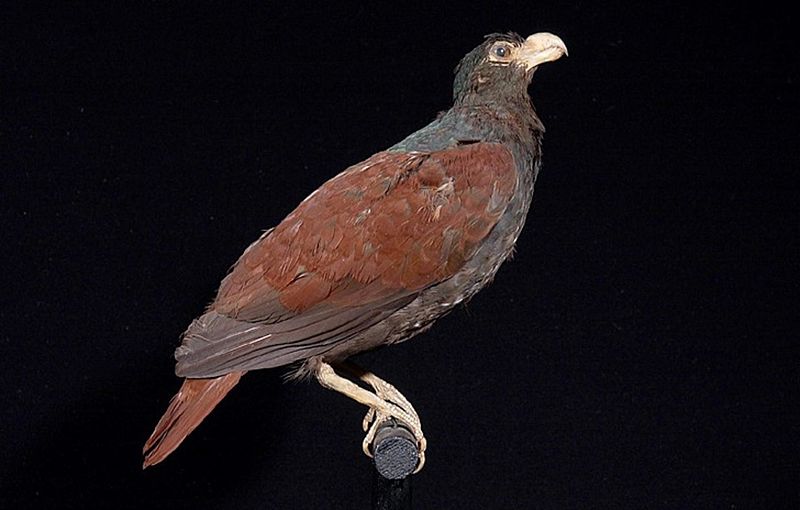
The Tooth-billed pigeon, also known as the manumea, is a large and beautiful bird that can only be found in Samoa. It’s an impressive species as it is the only living one of its genus – Didunculus.
The Tongan tooth-billed pigeon has been extinct for some time now; however traces have been found at various archeological sites in Tonga. This magnificent creature is even considered to be the national bird of Samoa.
Notable features include its bright red eyes and small ‘tooth’ like bill which gives this incredible species its name.
Its feathers are usually brown with areas of grey or white on them too, making it aesthetically pleasing to look upon when seen soaring through Samoan skies.Scientific classification:
| Kingdom | Animalia |
| Phylum | Chordata |
| Class | Aves |
| Order | Columbiformes |
| Family | Columbidae |
| Genus | Didunculus |
| Species | D. strigirostris |
24. Polynesian Ground Dove
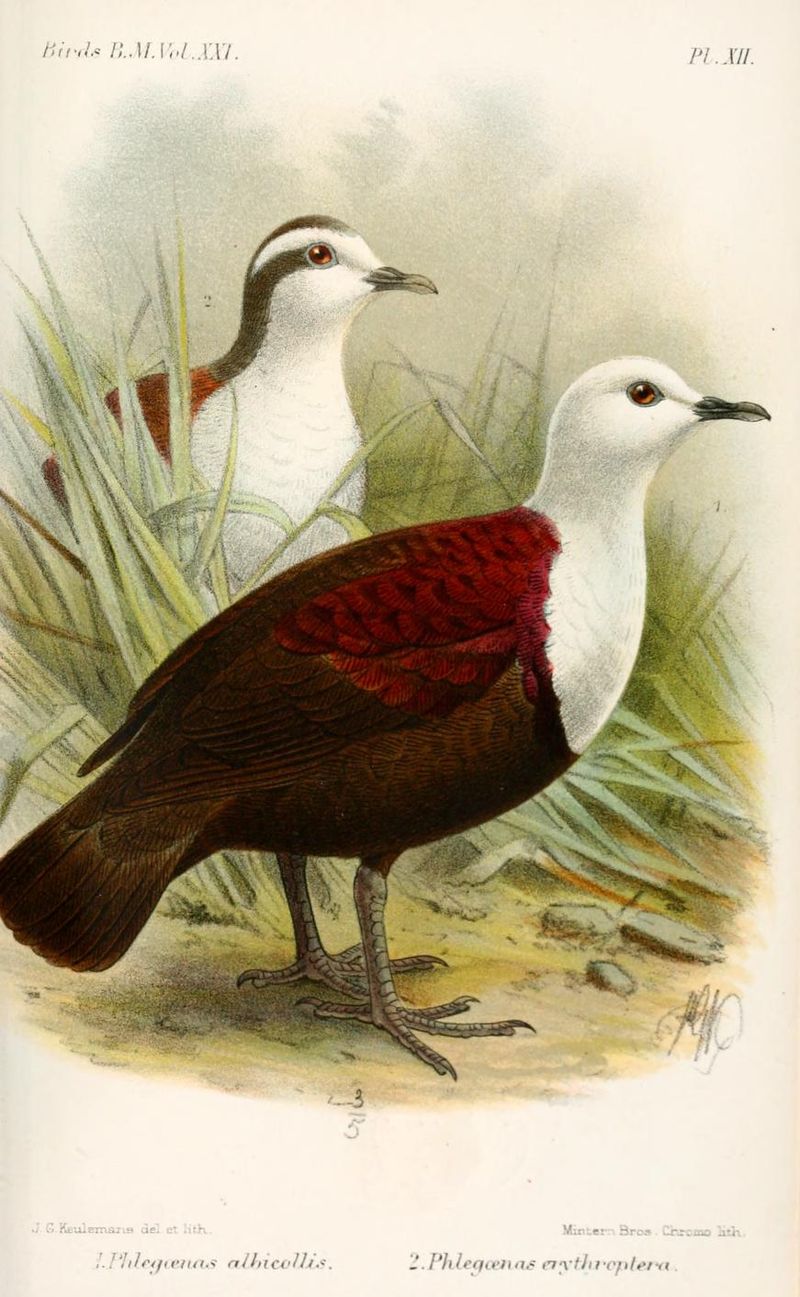
The Polynesian ground dove is an endangered species of bird belonging to the Columbidae family.
It was once endemic to French Polynesia’s Society Islands and Tuamotus, but has since been extirpated from most of its range due to habitat loss and predation by introduced cats and rats.
Now, it can only be found in the Acteon islands. This small dove has a grey-brown plumage with white spots on its wings and a distinctive red patch near its tail feathers.
Unfortunately, this beautiful creature faces extinction as human encroachment continues to threaten their habitats – making conservation efforts for these birds all the more important.Scientific classification:
| Kingdom | Animalia |
| Phylum | Chordata |
| Class | Aves |
| Order | Columbiformes |
| Family | Columbidae |
| Genus | Pampusana |
| Species | P. erythroptera |
25. Negros Fruit Dove
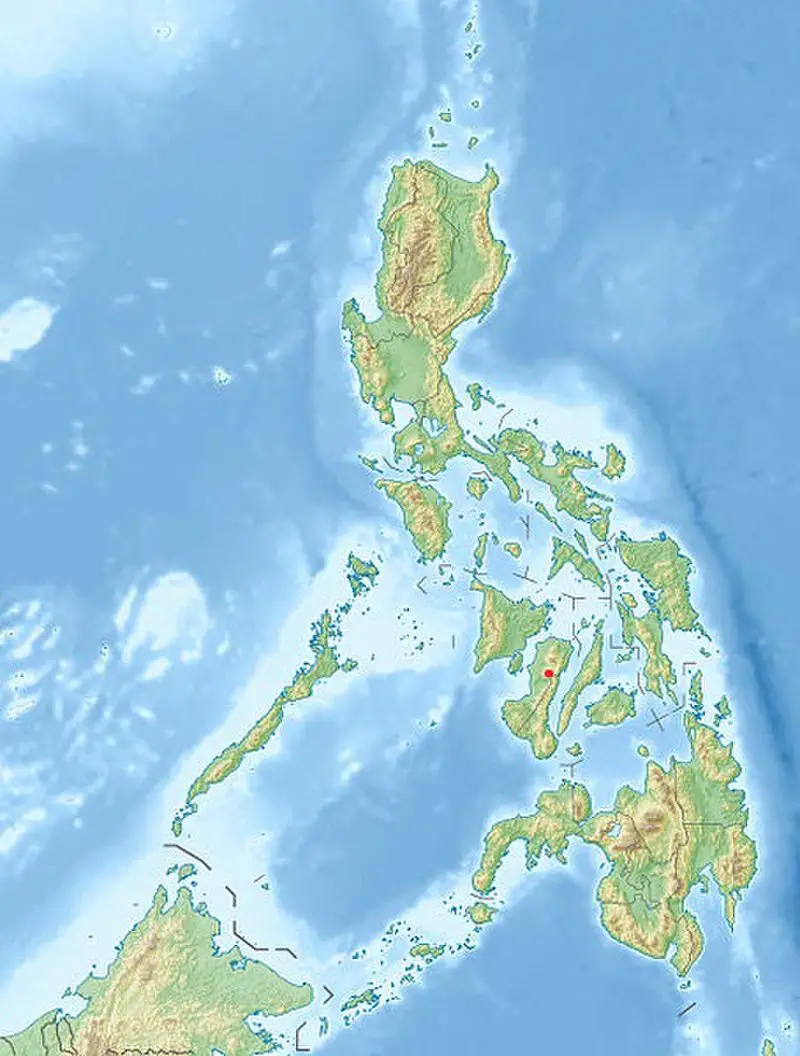
The Negros Fruit Dove is an endangered species of bird native to the island of Negros in the Philippines.
It was first discovered when a single female specimen was found on Mount Kanlaon, located in the northern part of the island.
Its overall plumage is bright yellow and green with reddish-brown wings and tail feathers. The dove feeds mainly on fruits such as papaya and banana, although it may also eat insects or other small animals occasionally.
Unfortunately, its population has been heavily impacted by logging activities that have caused much destruction to its habitat thus leading to a significant decline in numbers over time.
Conservation measures need to be taken soon if this beautiful species is going to survive into future generations.Scientific classification:
| Kingdom | Animalia |
| Phylum | Chordata |
| Class | Aves |
| Order | Columbiformes |
| Family | Columbidae |
| Genus | Ptilinopus |
| Species | P. arcanus |
Also Featured In: Common Philippines Birds, Most Common Birds in Negros
26. Ring-Necked Dove
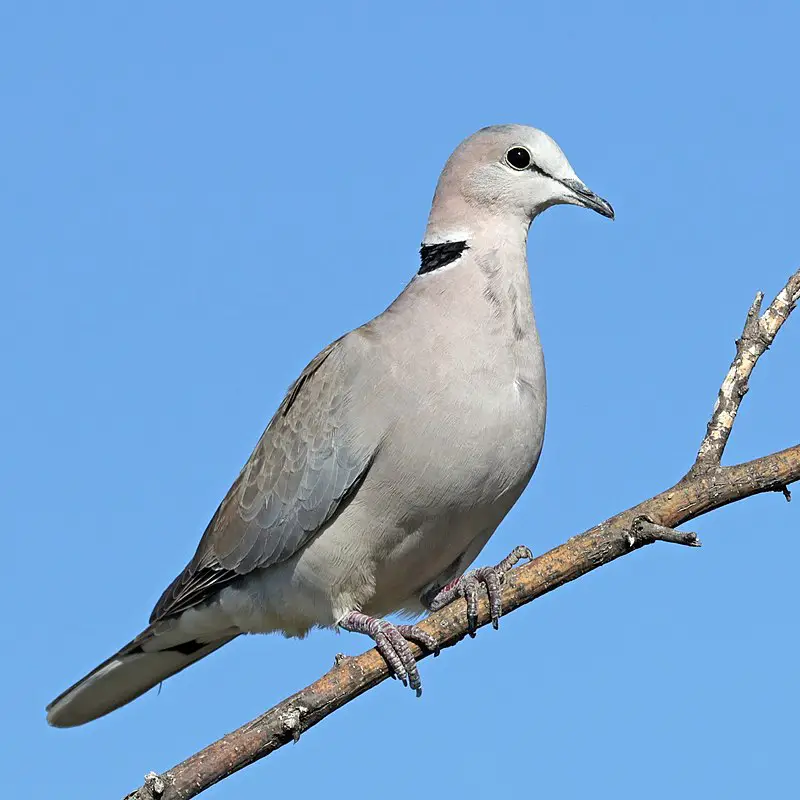
The Ring-necked Dove is a species of dove found in East and southern Africa. It is mostly sedentary, inhabiting open habitats such as woodlands and grassland savannas.
Its distinct call – a three syllabled crooning sound can often be heard throughout the year.
The name ‘Ring-necked’ comes from its characteristic black collar with white feathers around it’s neck which contrasts to its brown body.
It has single red eyes ring on each side of their head that gives them an alert expression at all times.
This bird feeds mainly on seeds but also eats other small fruits or flowers when available.
They are social birds, gathering together in flocks near food sources for safety against predators like hawks or cats during nesting season.Scientific classification:
| Kingdom | Animalia |
| Phylum | Chordata |
| Class | Aves |
| Order | Columbiformes |
| Family | Columbidae |
| Genus | Streptopelia |
| Species | S. capicola |
27. Brown Cuckoo-Dove
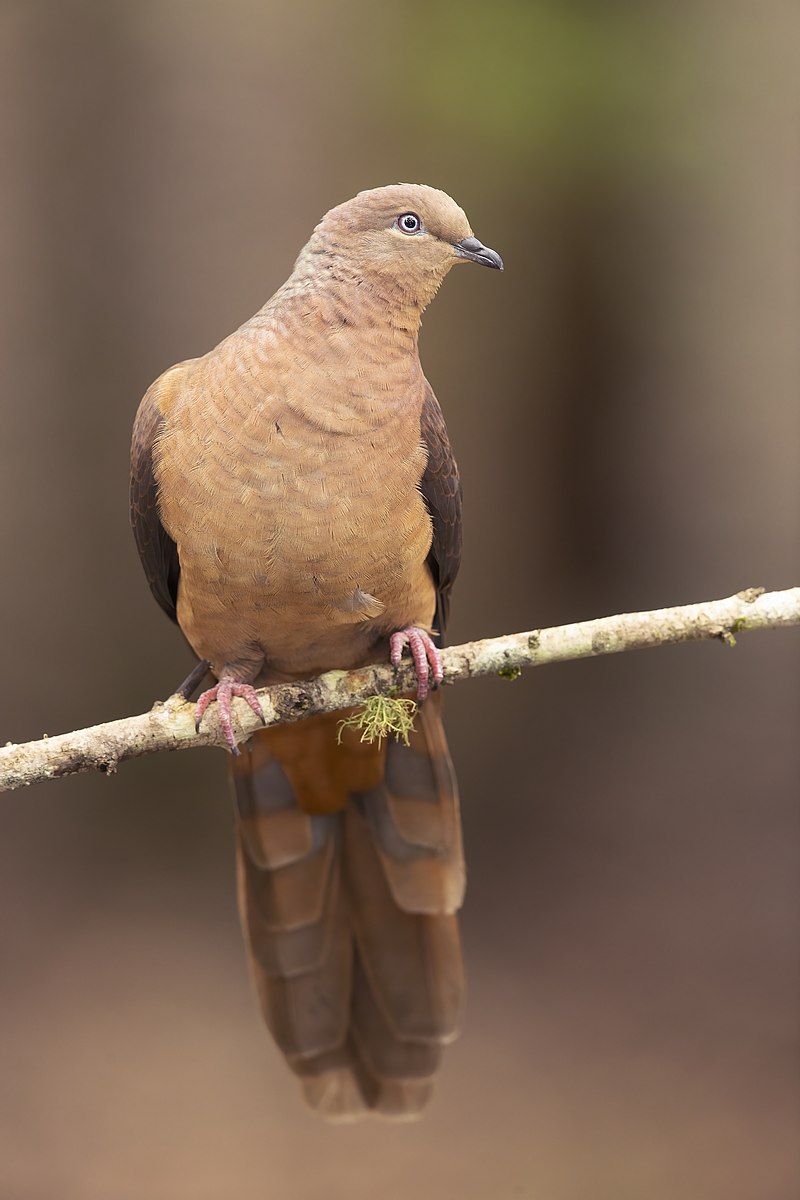
The brown cuckoo-dove, found in Australia from Weipa and Aurukun to Bega and inland at Atherton and Toowoomba, is a dove belonging to the genus Macropygia.
It has an overall brown plumage with spots of white on its wings. Its head is light greyish-brown while its tail feathers are tipped with black or dark grey bands.
The bird’s call is described as deep “booh” sound which it uses to communicate between individuals during mating season or when looking for food sources.
This species often frequents open woodland areas where they feed on seeds, fruit, buds, flowers and insects.
They also visit gardens for supplementary feeding opportunities such as breadcrumbs left by humans that attract these birds into urban environments throughout their range.Scientific classification:
| Kingdom | Animalia |
| Phylum | Chordata |
| Class | Aves |
| Order | Columbiformes |
| Family | Columbidae |
| Genus | Macropygia |
| Species | M. phasianella |
28. African Green Pigeon
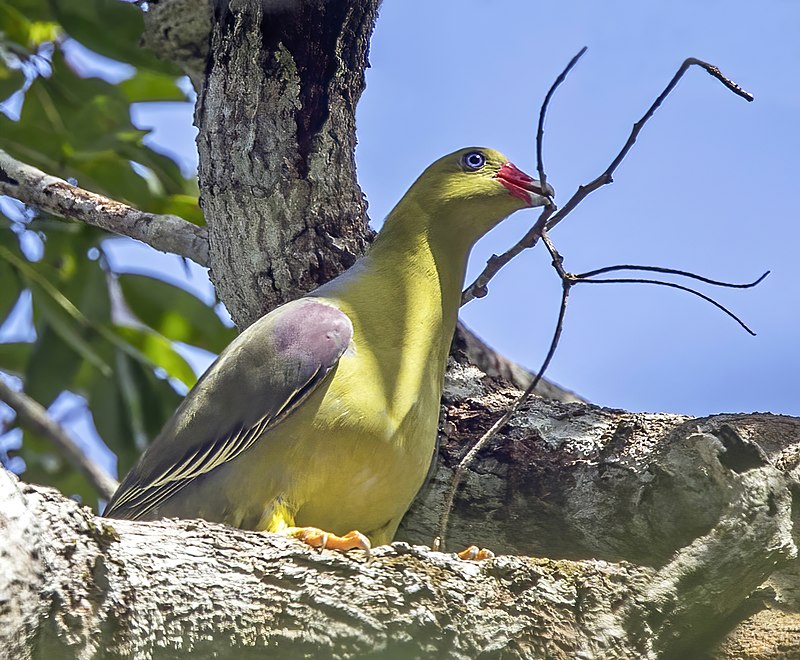
The African green pigeon is an incredibly unique bird that inhabits the Sub-Saharan Africa region.
It has a wide range of accepted races, and its adults have maroon patches on their wings while juveniles are olive in color.
Its upperparts can be grayish-green to yellowish-green with a white throat, barred underparts and clean legs. This species feeds mainly on fruit but may also consume seeds or insects.
It typically nests in trees near water or swamps where it builds platforms made from twigs for laying eggs which hatch after 2 weeks of incubation period by both parents sharing the duties equally .
The African green pigeon is quite vocal during mating season as well as when alarmed; often using whistles “kiu” notes to communicate with each other in flocks up to 30 birds at a time.Scientific classification:
| Kingdom | Animalia |
| Phylum | Chordata |
| Class | Aves |
| Order | Columbiformes |
| Family | Columbidae |
| Genus | Treron |
| Species | T. calvus |
29. Banded Fruit Dove
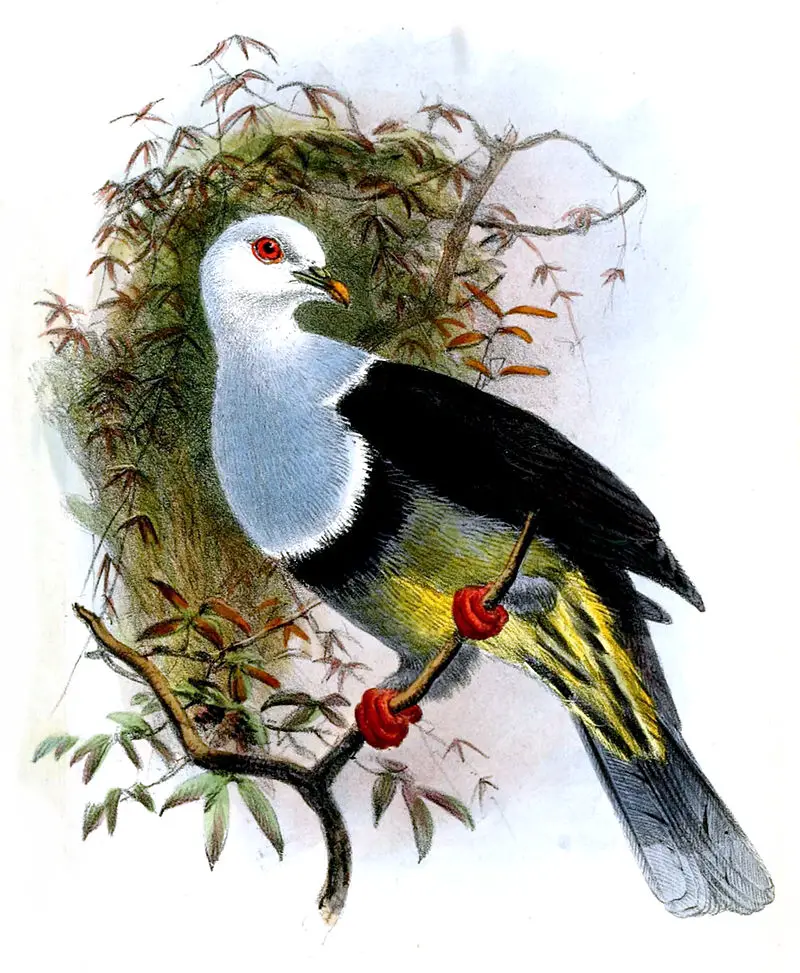
The Banded Fruit Dove is a stunning bird native to the Bali and Lesser Sunda Islands. It has an impressive wingspan of 38-44 cm, with a weight ranging from 450-570 g.
Its head, neck and upper breast are white while its back and upperwing have black colouring which gradually fades into grey on its rump.
The tail is all black but features a broad grey terminal band for contrast, whilst the underparts are also grey in colouration.
This species inhabits monsoonal forests where it can be seen searching for fruit amongst the foliage or perched high up in trees singing their beautiful song during mating season.
They may appear quite solitary however they usually live together as pairs or small groups depending on availability of food sources such as figs and other fruits found within their natural habitat range.Scientific classification:
| Kingdom | Animalia |
| Phylum | Chordata |
| Class | Aves |
| Order | Columbiformes |
| Family | Columbidae |
| Genus | Ptilinopus |
| Species | P. cinctus |
30. Ring-Tailed Pigeon
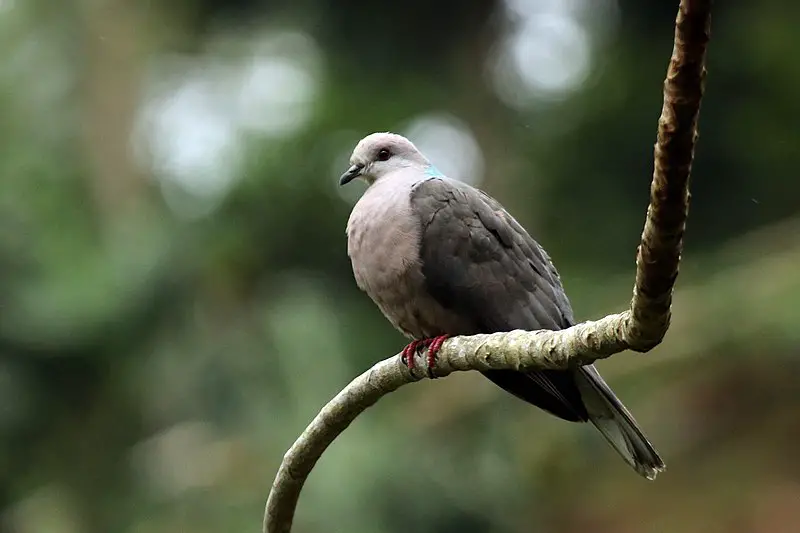
The Ring-tailed Pigeon is a beautiful species of bird endemic to Jamaica. It’s monotypic, and along with the Chilean pigeon and Band-tailed pigeon may form a superspecies.
The male can grow up to 48.5 cm while females are typically 38 to 43 cm long, boasting blueish green feathers – highlighted by black markings on their wings – white chests and bellies, iridescent bronze heads and tails with an unmistakable ring of white dots around its tail end.
They feed primarily on fruits found in trees but also consume small insects occasionally when available.
With conservation efforts ongoing it’s hoped that this wonderful species will enjoy many years ahead in its native land.Scientific classification:
| Kingdom | Animalia |
| Phylum | Chordata |
| Class | Aves |
| Order | Columbiformes |
| Family | Columbidae |
| Genus | Patagioenas |
| Species | P. caribaea |
31. Eared Dove
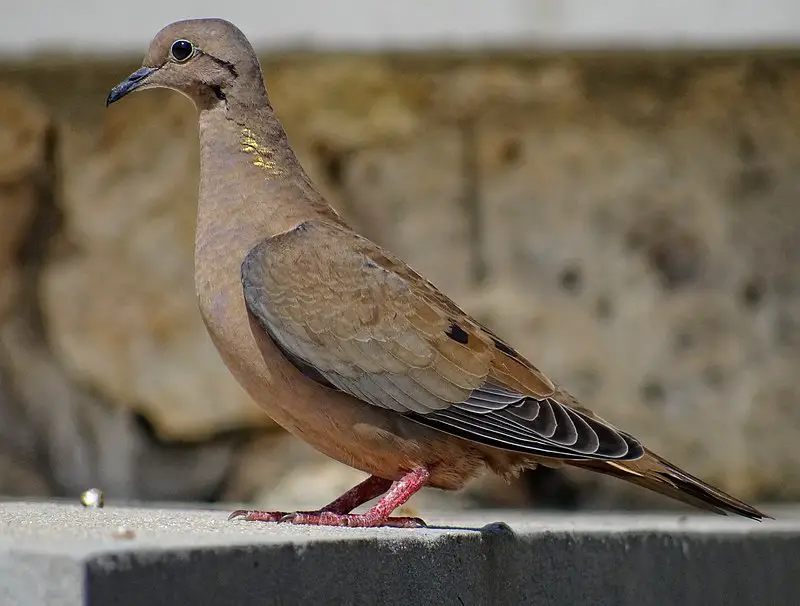
The Eared Dove is a beautiful bird that can be found throughout South America, ranging from Colombia to Argentina and Chile. It has also been spotted in Trinidad and Tobago recently.
This species tends to be partially migratory depending on food supplies available in the area, making it an important part of the local environment.
Its plumage tends to vary by region with some individuals having brighter colors than others where they are found near forested areas or along coasts.
The most recognizable feature of this dove is its ear tufts which gives it its common name – Eared Dove.
These doves have a soft cooing sound as their call which makes them truly unique among other birds in their range.Scientific classification:
| Kingdom | Animalia |
| Phylum | Chordata |
| Class | Aves |
| Order | Columbiformes |
| Family | Columbidae |
| Genus | Zenaida |
| Species | Z. auriculata |
32. Orange Fruit Dove
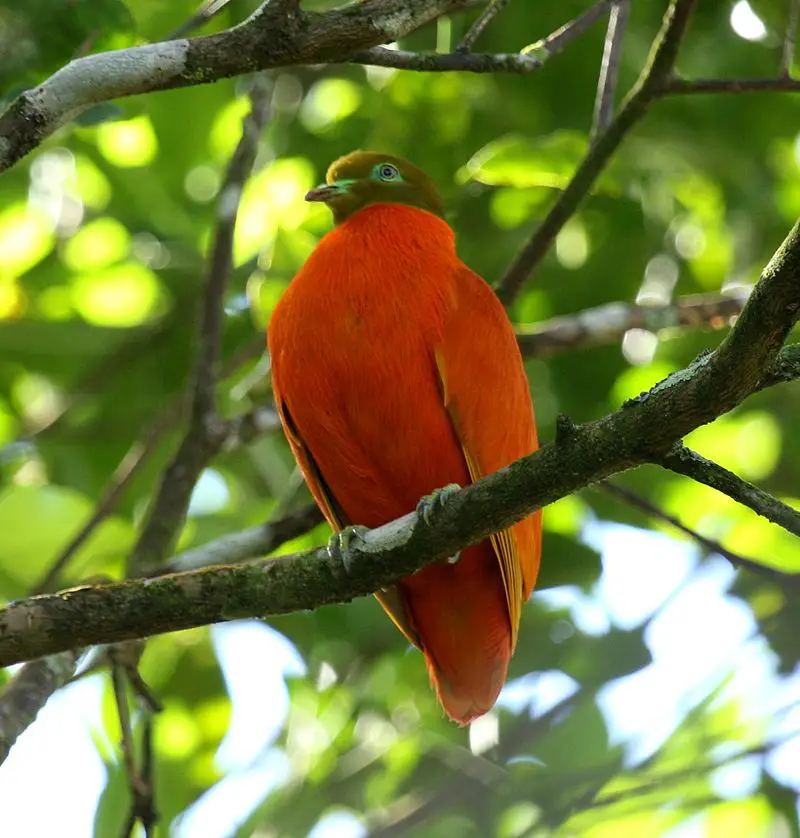
The Orange Fruit Dove is a stunningly colorful species of pigeon in the family Columbidae. The male has an olive green head and bright orange body feathers that look like hair when perched.
Its legs, bill, and skin around its eyes are bluish-green while its iris is whitish. In contrast to the vibrant colors of the males, females have more muted plumage with brown bodies accented by light spots on their wings.
They feed primarily on fruit found in tropical forests such as figs or berries but will also eat insects from time to time for added nutrients.
Their calls consist of soft cooing noises which can be heard throughout much of their range during mating season.Scientific classification:
| Kingdom | Animalia |
| Phylum | Chordata |
| Class | Aves |
| Order | Columbiformes |
| Family | Columbidae |
| Genus | Ptilinopus |
| Species | P. victor |
33. Black-Billed Wood Dove
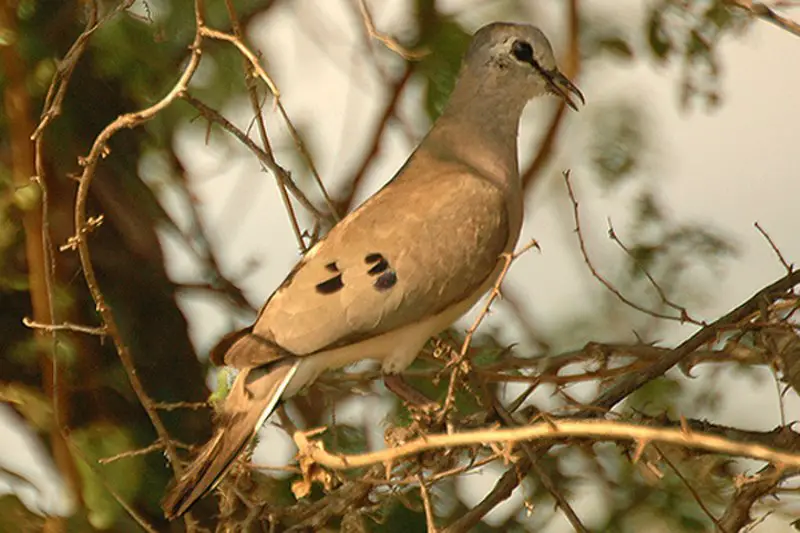
The Black-billed Wood Dove is a beautiful and widespread resident breeding bird found in Africa just south of the Sahara Desert.
It prefers near desert, scrub and savannah habitats to build its stick nest on an acacia tree or similar vegetation.
The dove lays two cream colored eggs which are incubated by both parents for about two weeks before hatching.
When flying, it has quick beats with occasional sharp flicks of wings characteristic of doves. Its diet consists mainly of seeds but also eats some insects and fruits when available during different parts seasons across their range.
This species makes delightful cooing soft sounds which can be heard from far away distances especially at dawns making them even more pleasant to have around.Scientific classification:
| Kingdom | Animalia |
| Phylum | Chordata |
| Class | Aves |
| Order | Columbiformes |
| Family | Columbidae |
| Genus | Turtur |
| Species | T. abyssinicus |
34. Somali Pigeon
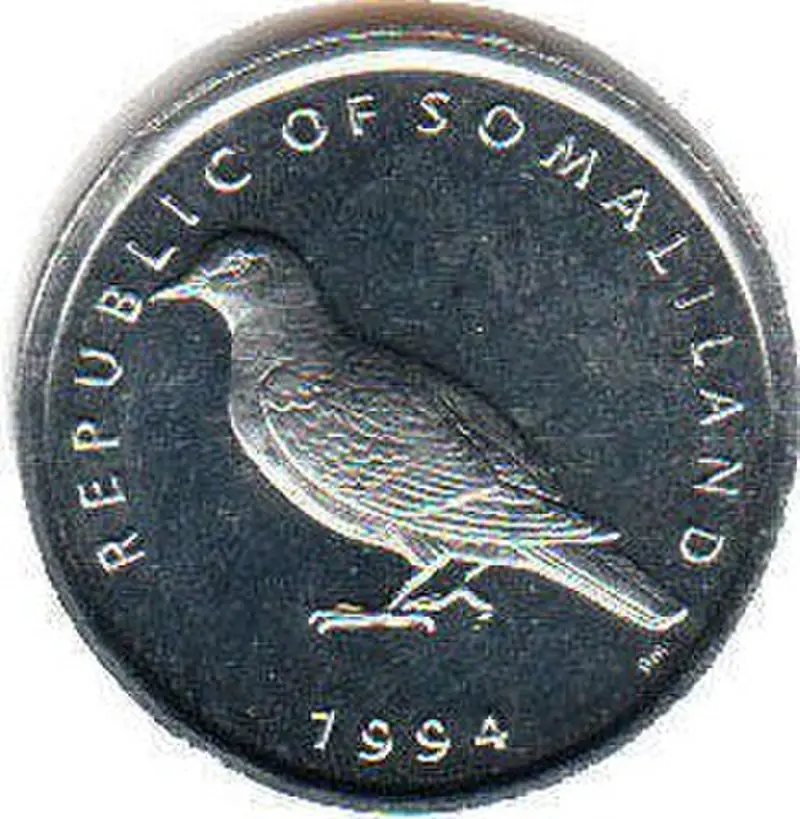
Somali pigeon is a species of bird endemic to Somalia, belonging to the Columbidae family.
It is believed that this rare bird’s population health has not been researched enough and may be threatened by speckled pigeons (Columba guinea).
This unique breed of dove typically sports greyish-brown feathers with darker spots near its head and wings.
Its chest area usually shows signs of pink or pale yellow hue while its face showcases dark violet colouration around their eyes and bill.
Somali Pigeon can often be seen in small flocks searching for food on grassy plains or rocky hillsides within Somalia.
Conservation efforts must continue in order to ensure these beautiful birds remain part of our eco-systems.Scientific classification:
| Kingdom | Animalia |
| Phylum | Chordata |
| Class | Aves |
| Order | Columbiformes |
| Family | Columbidae |
| Genus | Columba |
| Species | C. oliviae |
35. Sombre Pigeon
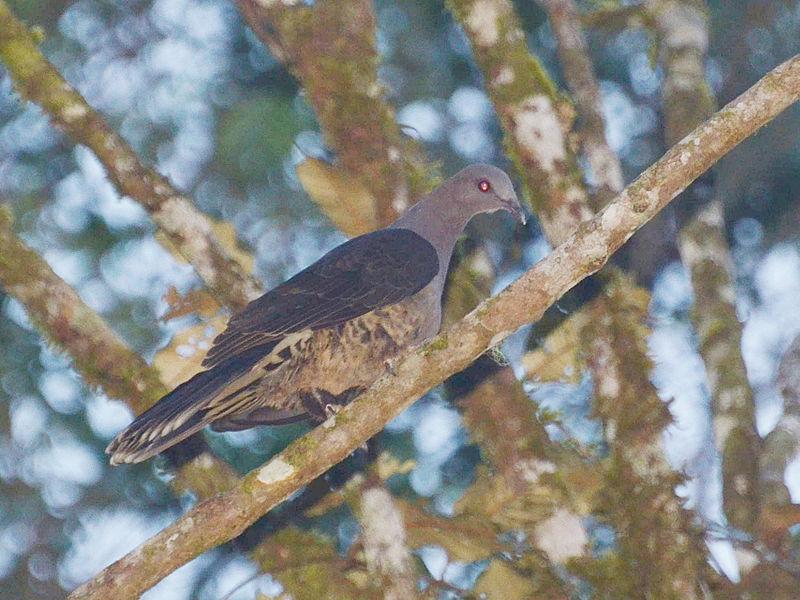
The Sombre pigeon is an extraordinary bird native to Indonesia’s Sulawesi island. It belongs to the family Columbidae and is the only species within its genus Cryptophaps.
This small, greyish-brown colored avian prefers moist montane forests as their natural habitat for shelter and food. Its diet consists of fruits, seeds, buds and sometimes invertebrates too.
Despite being a secretive bird with very minimal contact with humans, it has been listed on The IUCN Red List due to population decline in recent years.
Conservation efforts are now underway by local wildlife organizations in order to save this unique species from extinction.Scientific classification:
| Kingdom | Animalia |
| Phylum | Chordata |
| Class | Aves |
| Order | Columbiformes |
| Family | Columbidae |
| Genus | Cryptophaps Salvadori, 1893 |
| Species | C. poecilorrhoa |
36. Cloven-Feathered Dove
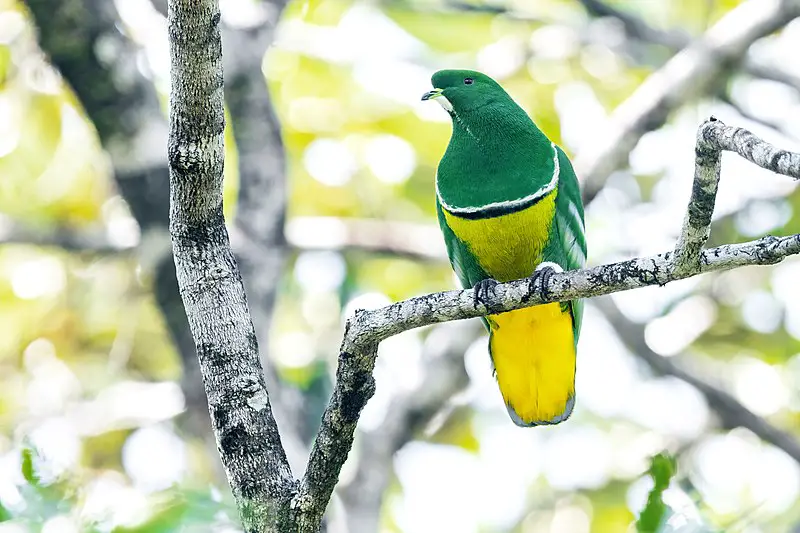
The Cloven-feathered Dove is a species of bird found only in New Caledonia, where it inhabits forests and Melaleuca savannas up to an altitude of 1,000 metres.
Its unique feathers are split into two distinct parts which give the bird its name. Unfortunately this beautiful species has been listed as near threatened by the IUCN due to deforestation and habitat loss caused by human activity.
It also faces threats from invasive predators such as cats, rats and mongooses that have been introduced to the island nation over time.
Conservation efforts must be taken if we want this fascinating creature to continue surviving on our planet for generations more.Scientific classification:
| Kingdom | Animalia |
| Phylum | Chordata |
| Class | Aves |
| Order | Columbiformes |
| Family | Columbidae |
| Genus | Drepanoptila Bonaparte, 1855 |
| Species | D. holosericea |
Also Featured In: Birds of New Caledonia,
37. Goliath Imperial Pigeon
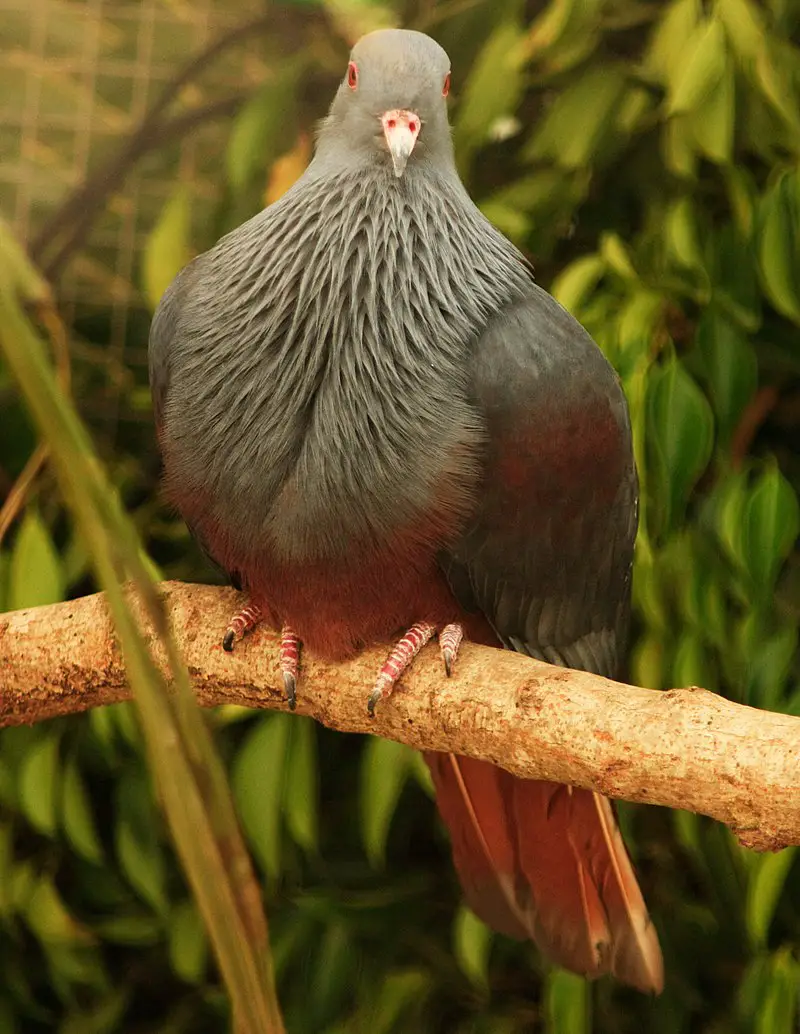
The Goliath Imperial Pigeon is an impressive bird, endemic to New Caledonia. This species belongs to the Columbidae family and has a near-threatened status according to the IUCN.
Its natural habitat consists of humid forests where it can find its food sources such as fruits and insects.
It was originally described as Carpophaga (Phænorhina) goliath by researchers in 1854 due to its large size compared with other pigeons from this genus.
With an overall grey coloring, males are known for their dark green breast feathers while females have more brownish tones on theirs.
For both genders, wings feature white patches which stand out against the background coloration of these birds when they take flight or land back into trees after feeding sessions at ground level during mornings or late eveningsScientific classification:
| Kingdom | Animalia |
| Phylum | Chordata |
| Class | Aves |
| Order | Columbiformes |
| Family | Columbidae |
| Genus | Ducula |
| Species | D. goliath |
38. White-Fronted Ground Dove
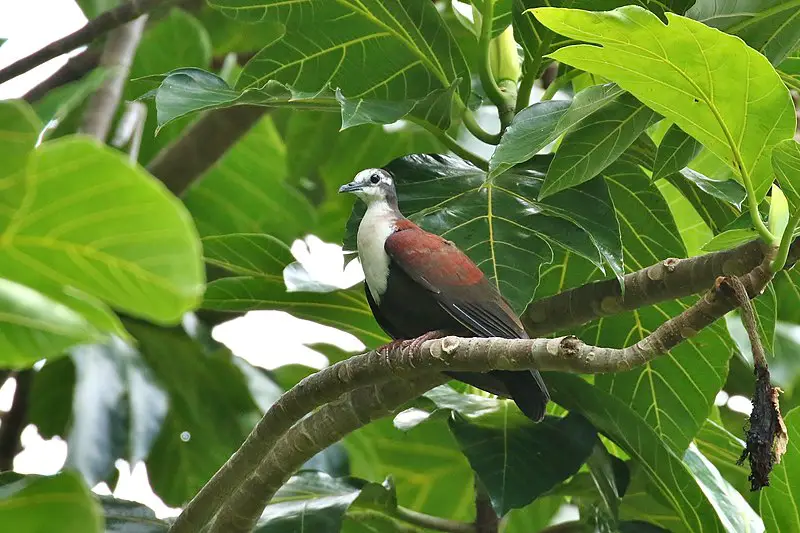
The White-fronted Ground Dove is an endemic species to Micronesia, found in lowland, montane and mangrove forests as well as shrublands and plantations.
It has a white forehead with black streaks on its neck and wings, along with greyish legs. Due to deforestation of it’s natural habitats, the dove faces threats such as habitat loss which puts this species at risk for extinction.
Conservation efforts need to be made in order preserve the fragile ecosystems these birds rely upon for survival.
Together we can help protect this bird by supporting reforestation initiatives or advocating against illegal logging operations that threaten their home range.Scientific classification:
| Kingdom | Animalia |
| Phylum | Chordata |
| Class | Aves |
| Order | Columbiformes |
| Family | Columbidae |
| Genus | Pampusana |
| Species | P. kubaryi |
39. Olive-Backed Quail-Dove
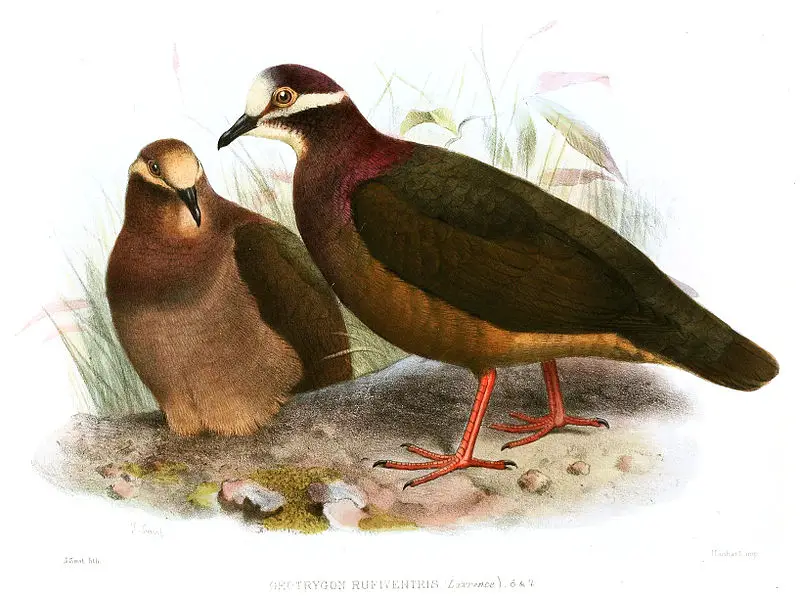
The Olive-backed quail-dove is a species of bird in the Columbidae family found mainly in Colombia, Costa Rica, Ecuador, Nicaragua and Panama.
It was initially put into the genus Geotrygon before being assigned to Oreopeleia and finally receiving its present name following a 2013 paper by the American Ornithological Society (AOS).
This small dove has an olive back with brownish grey sides as well as black spots on its neck and breast feathers. Its underparts are light grey while it also shows some white markings around its eyes.
They usually inhabit humid or semiarid forest areas where they feed primarily on fruits from trees like figs or palms.
Their diet can include insects too for additional protein intake during breeding season when their energy needs increase considerably due to nest building activities among others.Scientific classification:
| Kingdom | Animalia |
| Phylum | Chordata |
| Class | Aves |
| Order | Columbiformes |
| Family | Columbidae |
| Genus | Leptotrygon Banks et al., 2013 |
| Species | L. veraguensis |
40. Philippine Cuckoo-Dove
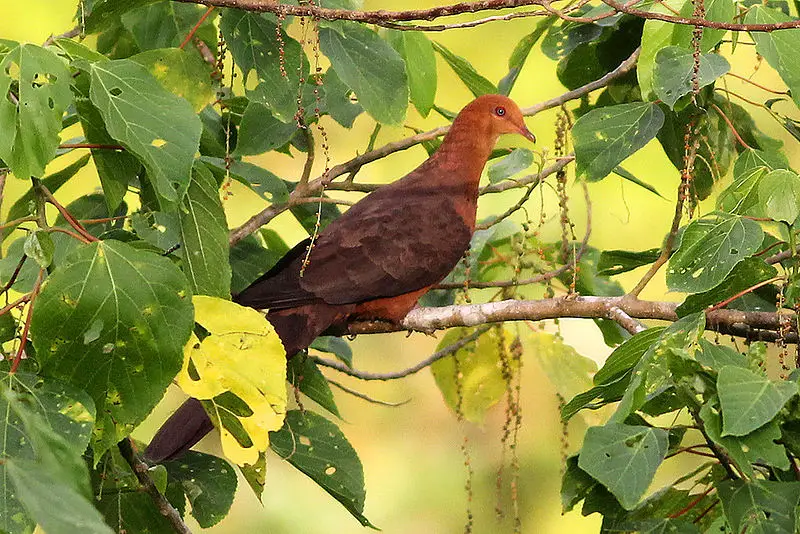
The Philippine cuckoo-dove is a species of bird found in the Philippines and Taiwan. It was first described by French zoologist Charles Lucien Jules Laurent Bonaparte in 1854, and is currently listed as a least concern species on the International Union for Conservation of Nature Red List of Endangered Species.
This dove typically has brownish grey plumage with white spots, long tail feathers, and black eyespots on its wings which it uses to startle predators away from nests or young birds.
Its diet consists mainly of fruits such as figs and berries along with some insects that are caught while perched low down amongst trees or bushes.
The Philippine cuckoo-dove tends to form pairs during breeding season but otherwise lives alone or within small groups outside this period.Scientific classification:
| Kingdom | Animalia |
| Phylum | Chordata |
| Class | Aves |
| Order | Columbiformes |
| Family | Columbidae |
| Genus | Macropygia |
| Species | M. tenuirostris |
Also Featured In: Mindoro Birds You Should Know,
41. Blue-Headed Quail-Dove
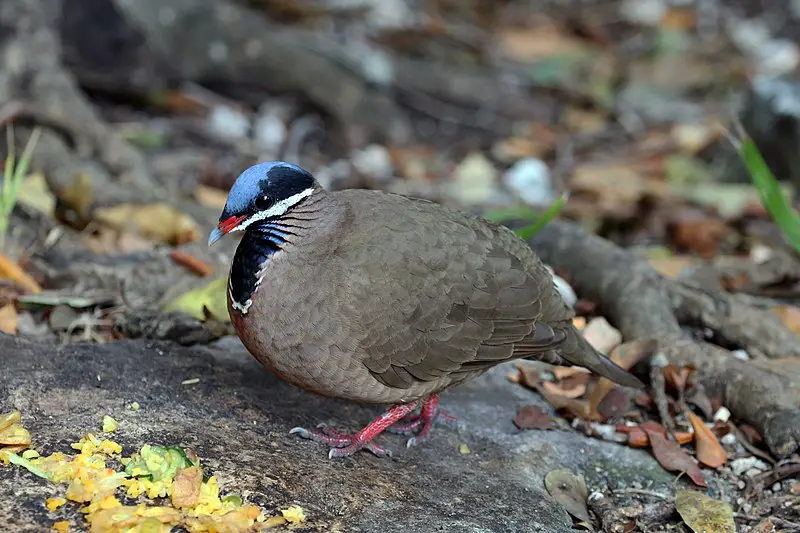
The Blue-headed Quail-dove is a species of bird in the Columbidae family, and is the only one within its subfamily Starnoenadinae and genus Starnoenas.
The English naturalist Eleazar Albin first described it back in 1734 with an accompanying drawing.
This beautiful bird has predominantly blue plumage on its head, neck and chest along with dark brown wings that are tipped white spotting their sides.
It also features red eyes alongside small black beaks typical to pigeons/doves as well as long legs for easy locomotion over land or through grassy areas.
Although they can fly short distances if necessary, this quail dove prefers to stay closer to ground level where it finds food such as seeds from grasses or weeds amongst other things.Scientific classification:
| Kingdom | Animalia |
| Phylum | Chordata |
| Class | Aves |
| Order | Columbiformes |
| Family | Columbidae |
| Genus | Starnoenas Bonaparte, 1838 |
| Species | S. cyanocephala |
42. Dwarf Fruit Dove
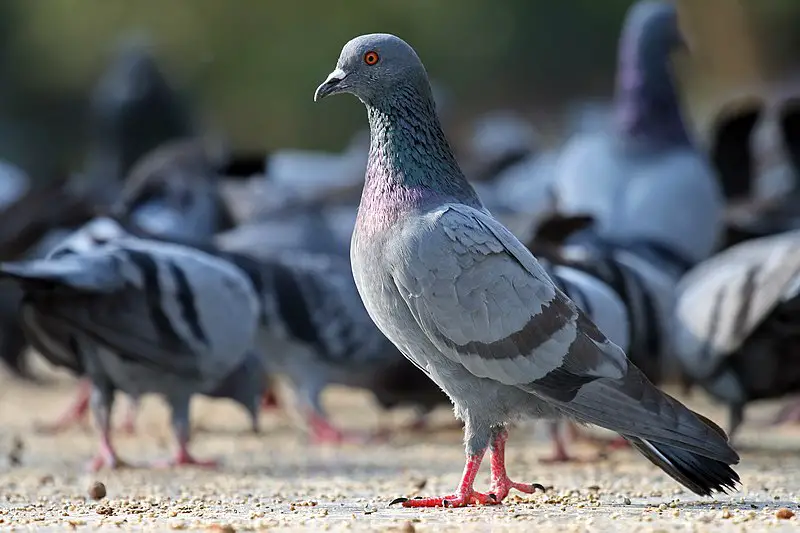
The Dwarf Fruit Dove, also known as the ‘Little Bronze-Cuckoo’ is a small bird native to Australia. It’s an olive green color with yellow and blue bars on its wings.
Its head has dark patches of feathers which are edged in white. The underside of this dove is pale greyish in colour while its tail is tipped with white bands and spots.
This species feeds mainly on fruits from trees such as figs, berries and bananas found near rainforests or woodlands where they prefer to nest during breeding season.
They can be heard cooing throughout the day indicating their presence nearby.
Their diet consists primarily of seeds but will consume insects when available too.
These lovely birds are considered quite shy yet have endearing personalities making them popular amongst enthusiasts who appreciate their beauty and gracefulness in flight
43. Claret-Breasted Fruit Dove
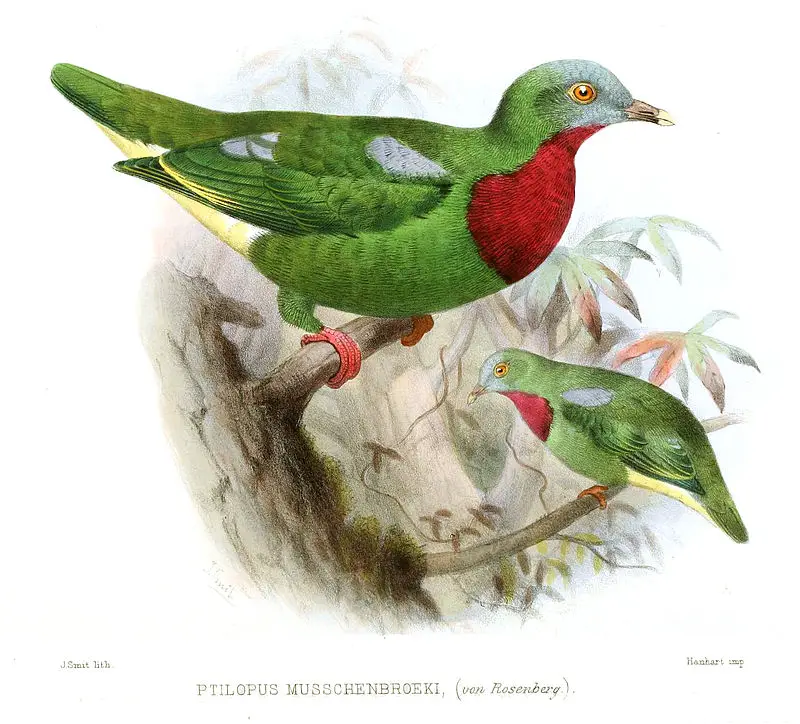
The Claret-breasted Fruit Dove is a stunningly beautiful bird with its deep claret color on its breast and wings, set against vibrant green.
It inhabits subtropical or tropical moist lowland forests from the Moluccas to New Guinea, as well as the Solomon Islands archipelago.
Originally described by French zoologist Mathurin Jacques Brisson in 1760, it has since been identified by many ornithologists for its distinctive appearance.
These birds can be seen eating fruit off of trees while they perch gracefully at high altitudes within their natural habitat.
They also build nests in tree hollows and other cavities, making them difficult to spot unless you know where to look.
The Claret-breasted Fruit Dove is an important part of any healthy rainforest ecosystem; without these colorful creatures our world would not be nearly so vibrant.Scientific classification:
| Kingdom | Animalia |
| Phylum | Chordata |
| Class | Aves |
| Order | Columbiformes |
| Family | Columbidae |
| Genus | Ptilinopus |
| Species | P. viridis |
44. White-Bellied Green Pigeon
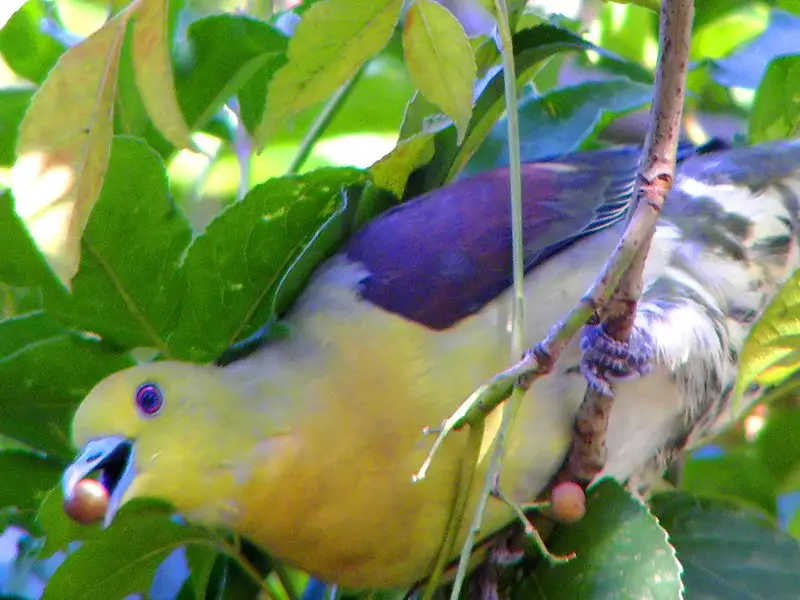
The White-bellied Green Pigeon is a species of bird that can be found in many parts of Asia. Its natural habitat is temperate forests, and it has an unusual habit: drinking saltwater.
This behavior was first observed at Terugasaki in Ōiso, Kanagawa Prefecture, Japan. It’s primarily green with a white underside; additionally the males have purplish patches on their wings while females do not.
They usually build nests together as pairs or small colonies near water sources such as rivers and lakes.
Along with other pigeons they feed mainly on fruits like berries and figs but also consume seeds grains insects and even nectar from flowers during certain times of year.
The White-bellied Green pigeon plays an important role in maintaining balance between nature’s ecosystem by dispersing seeds throughout its range which helps promote vegetation growth for years to come.Scientific classification:
| Kingdom | Animalia |
| Phylum | Chordata |
| Class | Aves |
| Order | Columbiformes |
| Family | Columbidae |
| Genus | Treron |
| Species | T. sieboldii |
45. Socorro Dove
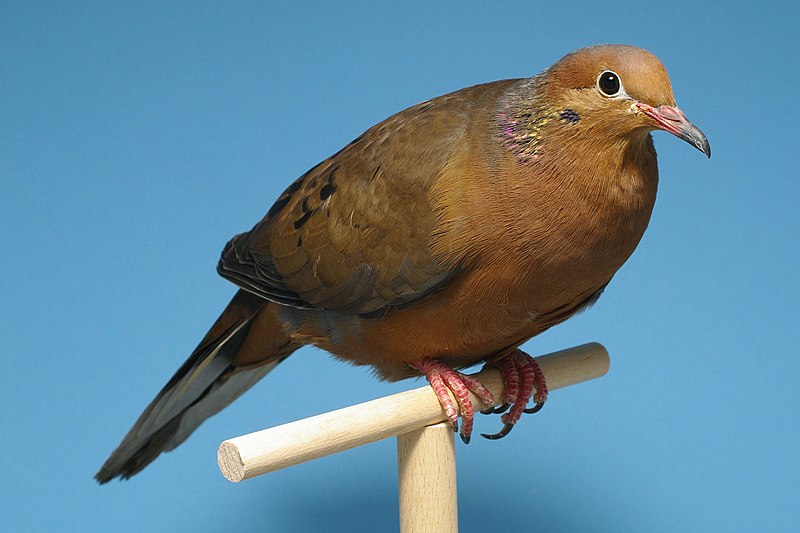
The Socorro dove (Zenaida graysoni) is a beautiful and unique species of bird that has sadly gone extinct in the wild.
It was native to Socorro Island, off the west coast of Mexico, but its last sighting there was in 1972.
There are now believed to be fewer than 100 purebred birds left alive in captivity, making this species one of the rarest on earth.
Fortunately, conservationists have begun planning for their reintroduction into their original habitat which would help safeguard them from extinction once again.
This dove is closely related to other North American doves such as Mourning Doves and White-winged Doves.
However, it stands out due its striking colouration – with grey wings against brownish body feathers – and distinctively long tail streamers.
With hope we can ensure these magnificent creatures remain part of our world for many more years to come.Scientific classification:
| Kingdom | Animalia |
| Phylum | Chordata |
| Class | Aves |
| Order | Columbiformes |
| Family | Columbidae |
| Genus | Zenaida |
| Species | Z. graysoni |
46. Namaqua Dove
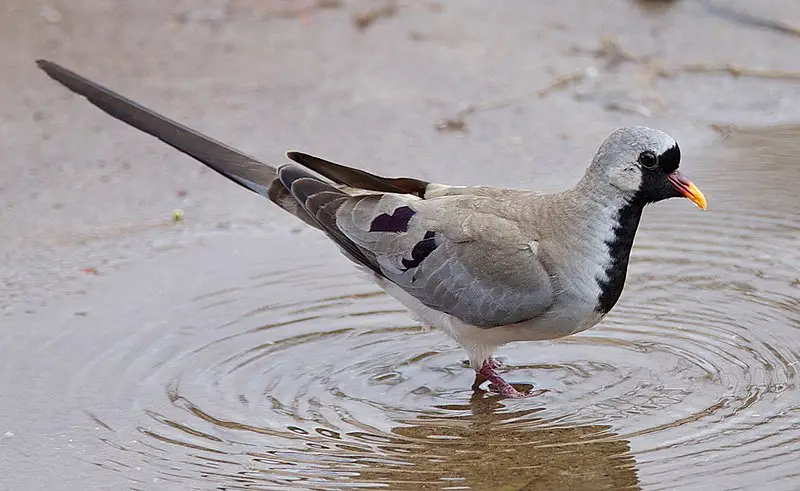
The Namaqua dove is a small pigeon that inhabits much of Sub-Saharan Africa, as well as Arabia and Madagascar.
It is the only species in its genus Oena, which has close affinities with the doves from Turtur.
Described for science by French zoologist Mathurin Jacques Brisson back in 1760, it typically measures between 26 to 28 cm long and boasts distinctive reddish plumage on its head, neck and breast region.
Its diet consists mainly of grains such as millet or wheat; however they may also feed on insects during dry spells when food sources are scarce.
The population size remains stable overall but localised declines have been observed due to human activities like habitat destruction and hunting for subsistence use or sport purposes.Scientific classification:
| Kingdom | Animalia |
| Phylum | Chordata |
| Class | Aves |
| Order | Columbiformes |
| Family | Columbidae |
| Genus | Oena Swainson, 1837 |
| Species | O. capensis |
47. Marquesan Imperial Pigeon
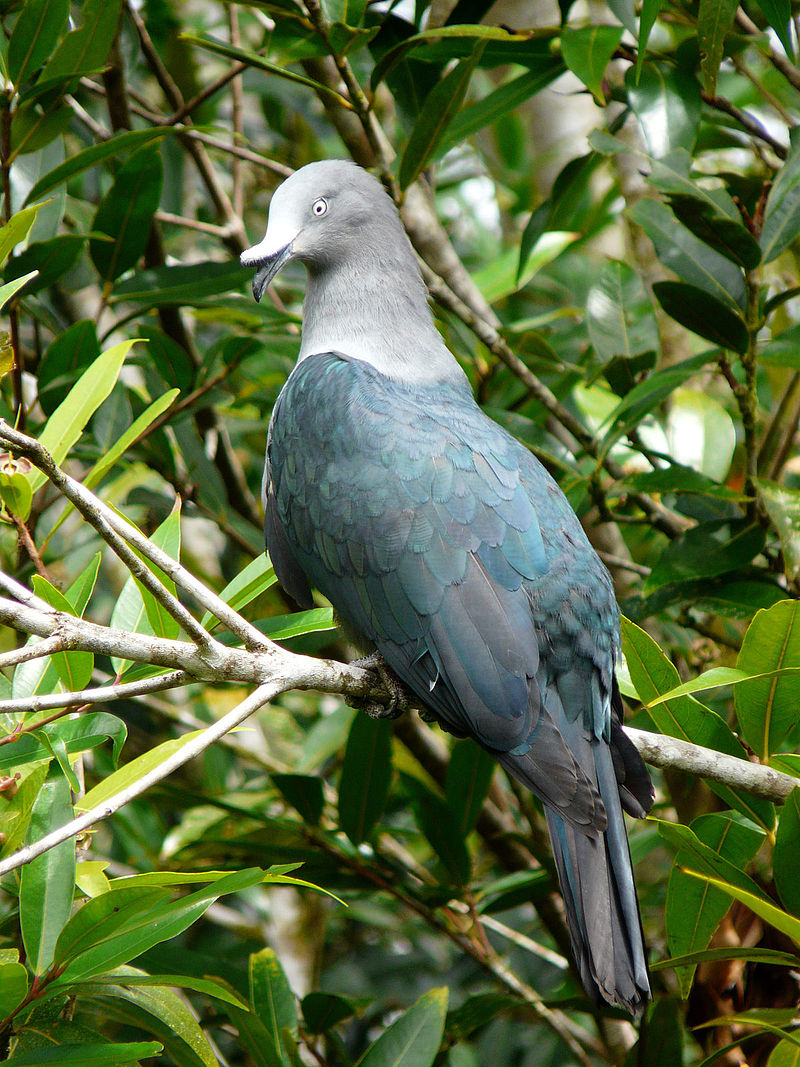
The Marquesan imperial pigeon is a large bird endemic to the Nuku Hiva island in French Polynesia. It has an impressive size, with males reaching up to 50-53 cm and weighing around 900 grams.
This puts it among the largest pigeons outside of crowned pigeons. Its plumage is mainly greyish blue on its back and head, while chestnut brown covers its wings and tail feathers.
It also features black spots near its eyes which are somewhat triangular shaped and point downwards towards the beak area.
The Marquesan imperial pigeon can be found primarily in some valleys located at western part of Nuku Hiva Island where they feed on fruit such as guava or bananas that grow there naturallyScientific classification:
| Kingdom | Animalia |
| Phylum | Chordata |
| Class | Aves |
| Order | Columbiformes |
| Family | Columbidae |
| Genus | Ducula |
| Species | D. galeata |
48. Blue Ground Dove
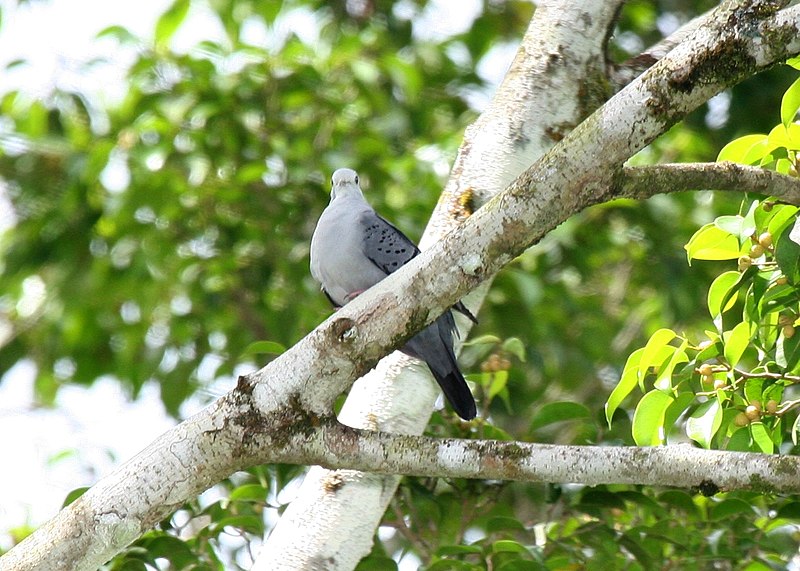
The Blue Ground Dove is a stunningly beautiful bird found in tropical areas of North, Central and South America.
It has an iridescent blue-green back with a gray head and wings, while its breast is pinkish orange in color.
This small dove lives mainly in open woodlands, forest edges, clearings and roadsides – particularly around more humid regions – from sea level to about 1 200 meters altitude.
The species builds cup shaped nests out of twigs which it places on trees or shrubs usually near water sources.
These birds are quite common but their numbers have unfortunately been decreasing due to habitat loss caused by deforestation for agricultural purposes as well as hunting pressure from humans who use them for food or trapping baitbirds.Scientific classification:
| Kingdom | Animalia |
| Phylum | Chordata |
| Class | Aves |
| Order | Columbiformes |
| Family | Columbidae |
| Genus | Claravis Oberholser, 1899 |
| Species | C. pretiosa |
49. Whistling Fruit Dove
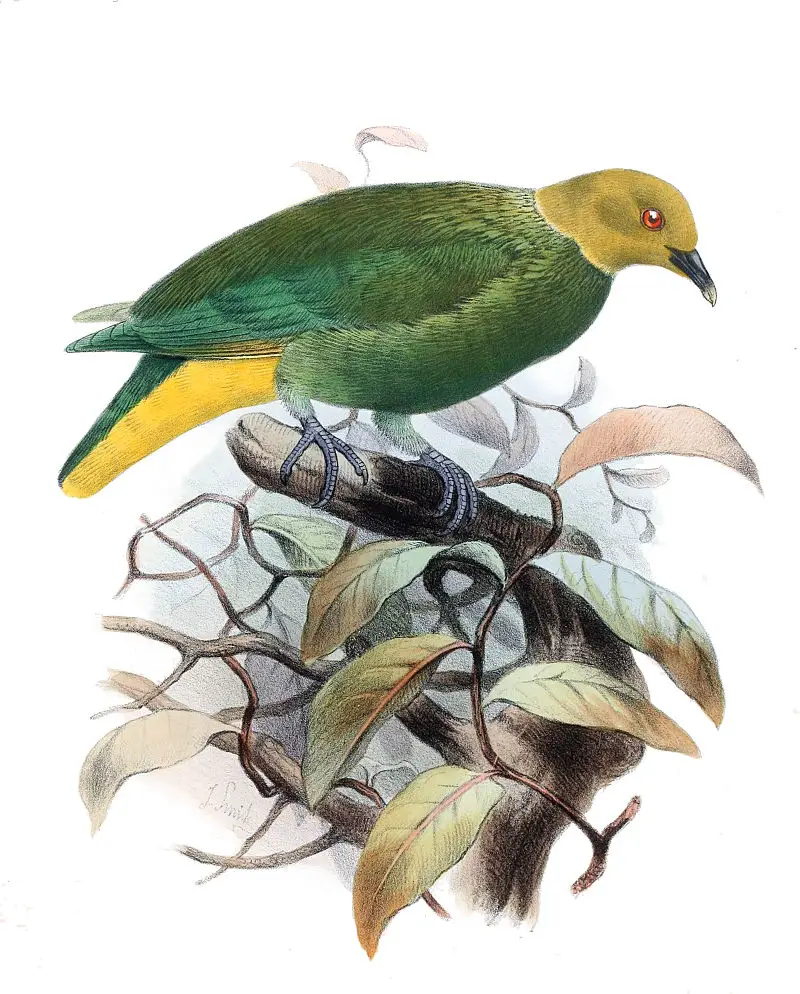
The Whistling Fruit Dove is a small and beautiful fruit dove native to the Kadavu Group islands in Fiji. It has an unmistakable yellow head, bright greenish-blue back and wings, as well as white underparts.
This species of bird loves eating fruits, which it finds on tropical trees or shrubs. Its distinctive call is similar to whistling; hence its name.
The Whistling Fruit Dove is the most primitive subgroup of Ptilinopus doves found in Fiji along with two other Fijian species – the golden dove and purple-crowned lorikeet.
These birds are relatively common but still vulnerable due to habitat destruction caused by deforestation for development purposes.
They can also be threatened by predation from domestic cats and rats that have been introduced into their habitats.Scientific classification:
| Kingdom | Animalia |
| Phylum | Chordata |
| Class | Aves |
| Order | Columbiformes |
| Family | Columbidae |
| Genus | Ptilinopus |
| Species | P. layardi |
50. Inca Dove
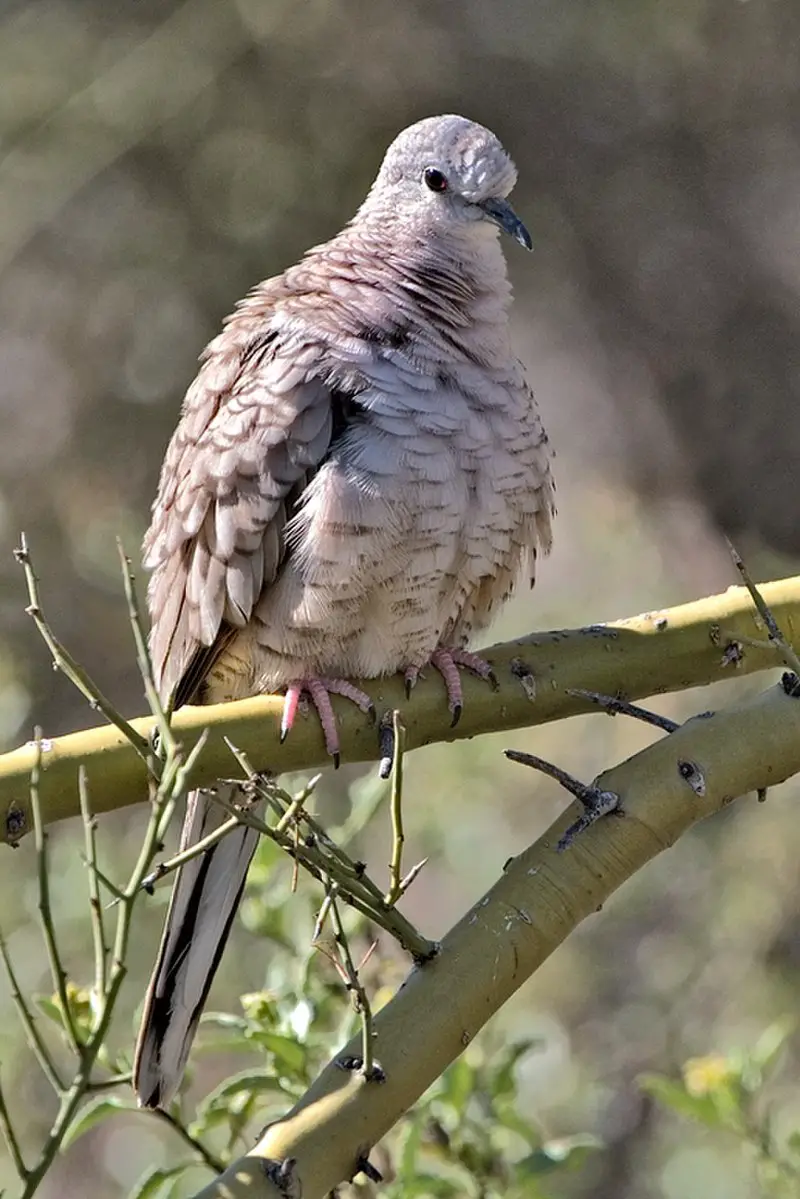
The Inca Dove is a small, slender bird found in the New World. It has an average length of 16.5–23 cm and weighs about 30-58 gm. Its wingspan measures around 28.5cm but can reach up to 32cm at max.
The body of this dove is grayish brown with feathers that are rounded off tips giving it a soft look overall.
This species was first described by French surgeon and naturalist René Lesson back in 1847 and since then have been living happily all over North America from Mexico through Texas to South Dakota, Kansas as well as parts of Arizona among others regions too.Scientific classification:
| Kingdom | Animalia |
| Phylum | Chordata |
| Class | Aves |
| Order | Columbiformes |
| Family | Columbidae |
| Genus | Columbina |
| Species | C. inca |